
































































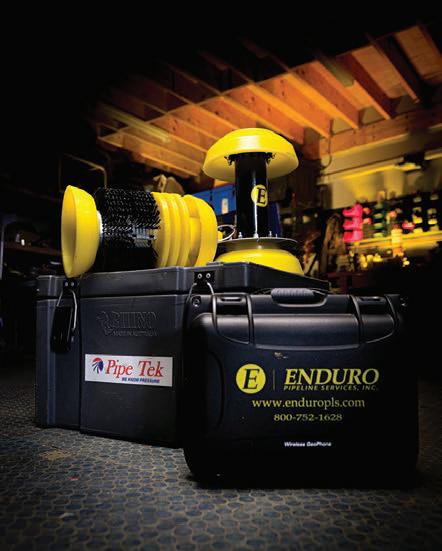
Save time, money and ensure the quality of your assets by choosing an experienced partner who can manage and respond quickly to all your pipeline integrity needs.
› Pigging
› Inline Inspection
› Live line dig ups
› NDT, including verification by phased array
› Leak detection
› Welding and field joint coating repair

› NATA pressure testing up to 70,000 kPa

› Flexible set-ups for remote and limited footprint locations
› Fast emergency response
Taddam: 0432 666 917 taddam@pipetek.com.au
Myles: 0417 707 729 myles@pipetek.com.au
Nacap’s recent 580km major gas pipeline project for APA Group in Western Australia, the Northern Gold elds Interconnect Pipeline. ImagesuppliedbyNacap.




CEO
John Murphy COO
Christine Clancy christine.clancy@primecreative.com.au
MANAGING EDITOR
Molly Hancock molly.hancock@primecreative.com.au
EDITOR
Clemence Carayol clemence.carayol@primecreative.com.au
JOURNALIST
Vivien Topalovic vivien.topalovic@primecreative.com.au
BUSINESS DEVELOPMENT MANAGER
Jake Niehus jacob.niehus@primecreative.com.au
DESIGN PRODUCTION MANAGER
Michelle Weston michelle.weston@primecreative.com.au
ART DIRECTOR
Blake Storey blake.storey@primecreative.com.au
DESIGNERS
Kerry Pert
COPYRIGHT
The Australian Pipeliner is owned by Prime Creative Media and published by John Murphy. All material in The Australian Pipeliner is copyright and no part may be reproduced or copied in any form or by any means (graphic, electronic or mechanical including information and retrieval systems) without written permission of the publisher. The Editor welcomes contributions but reserves the right to accept or reject any material. While every effort has been made to ensure the accuracy of information, Prime Creative Media will not accept responsibility for errors or omissions or for any consequences arising from reliance on information published. The opinions expressed in The Australian Pipeliner are not necessarily the opinions of, or endorsed by the publisher unless otherwise stated. © Copyright Prime Creative Media, 2021
All articles submitted for publication become the property of the publisher. The Editor reserves the right to adjust any article to conform with the magazine format.

Printed by: The Precision Group
83-89 Freight Drive, Somerton VIC 3062
Ph: (03) 9490 1500
The Australian Pipeliner brand comprises: a quarterly magazine, a news website, a fortnightly e-newsletter, multiple social media platforms, an annual industry directory and an annual pipelines wallchart. Book an advertising and editorial package to gain access to our exclusive audience.
3,300+
20,000+ website views each month
13,700+ social media followers magazine subscribers
16,500+ e-newsletter subscribers
Want to find out more?
Contact our business development team to discuss how you can grow your business with The Australian Pipeliner. Call 0466 929 675 or email jacob.niehus@primecreative.com.au
Head Office 379 Docklands Drive, Docklands VIC 3008 Ph: (03) 9690 8766
Sydney Office Suite 303, 1-9 Chandos Street, Saint Leonards NSW 2065 Ph: (02) 9439 7227
enquiries@primecreative.com.au www.primecreative.com.au
The Australian Pipelines and Gas Association’s (APGA) vision is to lead the sustainable growth in pipeline infrastructure for Australasia’s energy. APGA is a non-profit organisation formed to represent the interests of its members involved in: the ownership, operation, maintenance, design, engineering, supply and construction of pipelines, platforms and all other structures used in or in connection with the drilling for, extraction and transmission of hydrocarbons, solids, slurries and similar substances both onshore and offshore. As a single voice representing the collective interests of its members, APGA is dedicated to encouraging the extension and development of the industry.
The Australian Pipeliner is the official journal of the Australian Pipelines and Gas Association (APGA) and is distributed to members without charge and circulated to interested organisations throughout Australia and overseas. It is also available on subscription. The publishers welcome editorial contributions from interested parties. However, neither the publishers nor APGA accept responsibility for the content of these contributions and the views contained therein are not necessarily the views of the publishers or APGA. Neither the publishers nor APGA accept responsibility for any claims made by advertisers. All communications should be directed to the publishers.
Abletech Underground is recognised as a trusted leader in providing industry solutions for a wide range of sectors and industry projects.
Abletech Underground brings a wealth of experience and capabilities to the energy sector, approaching each pipeline project with the utmost e ciency. We have the ability to mobilise Australia-wide, understanding individual site requirements. We ensure our clients’ needs are met while establishing long-term professional relationships founded on personalised service, reliability, and e ciency.
Abletech Underground has unmatched expertise gained from our extensive involvement with a multitude of challenging large-scale projects. Our highly skilled team, up-to-date industry accreditations, state-of-the-art equipment, industry leadership, ISO certifications, and attention to detail.


Welcome to the latest edition of e Australian Pipeliner. e year has started rmly with well-attended networking evenings, golf days, and a series of technical seminars and symposiums, with events stretching from New Plymouth in New Zealand to Perth. In particular, I wanted to mention the mini-seminars held as part of the networking evenings. is is a new initiative designed to provide both excellent networking opportunities and valuable insights through informative seminar sessions. I encourage you to attend the next one, and if you have something that you would like to share, the mini-seminar is a great format to do it in. It has been great catching up with many industry participants with signi cant ongoing projects nationwide.
Also occurring in the first part of the year was the Australian Domestic Gas Outlook Conference in Sydney. Again, it was wellattended, with several keynote presentations from many APGA members, including our Chief Executive Officer, Steve Davies, and National Policy Manager, Jordan McCollum. A key theme of this conference was unlocking potential gas supply opportunities. While we have seen a positive shift in the public debate, with the role of gas in the energy transition becoming more widely understood and accepted, it needs to translate into releasing the potential of our domestic supply. This reinforces our need to engage with policymakers, regulators, and stakeholders to advocate for policies that support new opportunities.
The infrastructure of our industry plays a crucial role in Australia's energy mix, in its use for electricity generation, heating, industrial processes, and as a feedstock for various industries. Our Future Fuels CRC (FFCRC) focuses on technologies, systems, and markets while supporting social acceptance, public safety, and supply security. This edition of the magazine features the critical work that the FFCRC have been completing and a focus on collaborating with industry partners, research institutions, and government agencies to develop and deploy innovative technologies for emission reduction.
Recognising the strategic importance of fostering international collaboration and addressing the future of gas infrastructure, APGA has awarded five scholarships to Young Pipeline Professionals and Women in Pipelines members to facilitate their attendance at the Emerging Fuels Symposium in Greece in May 2024. The Emerging Fuels Symposium, a new initiative highly relevant to the global industry, is an opportunity to discuss and exchange insights on emerging trends.
During the past few years, several longdistance, cross-country pipelines have been delivered in Western Australia, which is our regional focus for this edition. With several projects underway and future development planned, it is a timely review. Future projects for water supply, desalination, gas pipelines to power generation, and hydrogen and alternative fuel initiatives headline the future opportunities in the 'pipeline'.

T: +61 2 6273 0577
E: apga@apga.org.au
W: www.apga.org.au
The Secretariat has been working hard to prepare for our Annual Convention in Adelaide from 12 to 15 of October 2024 at the convention centre. Adelaide always puts on a great show when we visit each time. Registrations are now open, and event program details can be found on our website. As our flagship event, it facilitates knowledge exchange through comprehensive business sessions, while the planned social gatherings foster extensive networking opportunities. An important part of the Convention is the Annual award presentations. APGA presents awards to individuals and companies in recognition of their services to the nation’s pipeline industry. There are six annual awards with nominations currently open. I encourage all members to put found their nominations which are also open now.
Stay safe and I look forward to seeing you at the next event.
 JOHN STUART-ROBERTSON APGA PRESIDENT
JOHN STUART-ROBERTSON APGA PRESIDENT
Chief Executive Officer
Steve Davies
Corporate Services Manager
Michelle Wickson
National Policy Manager
Jordan McCollum
Communications Manager
Lawrence Shelton
Engagement Manager
Gayle Burns
Membership Officer
Katy Spence
Policy Manager
Catriona Rafael
Government Relations Manager
Paul Purcell

Lightweight
BlackMAX
Even those who don’t keep much of an eye on energy policy will likely have come across the phrase ‛Supercharged Integrated System Plan (ISP)’ throughout 2023. APGA National Policy Manager Jordan McCollum has deciphered the plan and its grey areas.
APGA National Policy Manager Jordan McCollum
The Supercharged Integrated System Plan (ISP) was heralded as the solution to all energy system planning woes, delivering much needed integration of electricity and gas system planning. But the product may in fact be more super- op than supercharged.
A recently published Energy Ministers’ response to a Department of Climate Change, Energy, the Environment and Water (DCCEEW) review into the ISP shows that the nal recommendations around a supercharged ISP fall far short of their potential.
e review into supercharging Australian Energy Market Operator (AEMO) ISP forecasting responsibilities started with much promise for gas customers. e Terms of Reference (ToR) for the review talks about energy, not just electricity, focusing on the ISP as a ‘whole-of-system plan’. e ‘increasing interrelationship between gas and electricity’ is centre to the ToR which noted that ‘there is considerable uncertainty about potential transition pathways’. e ToR went on to state that a ‘Supercharged’ ISP is expected to be an integrated transition plan for the National Electricity Market (NEM) and the East Coast Gas Market (including hydrogen and renewable gases as the industries develop) that considers the generation, storage, transmission and distribution requirements to maintain a ordable and reliable energy for all consumers as Australia transitions to net zero emissions.
Statements such as ‘the NEM and the East Coast Gas Market and a ordable and reliable energy for all consumers’ implied that a Supercharged ISP would genuinely consider all energy supply chain options – including renewable electricity and renewable gas options – when considering least cost energy supply through the net zero transition for todays’ energy customers, gas and electric alike.
A Supercharged ISP combining analysis of electricity and gas consumption and supply chains would have the potential to drive so much progress for decarbonisation in Australia. Renewable gases could be considered alongside renewable electricity as a viable decarbonisation option for gas customers. Cheaper gas and

Cheaper gas and hydrogen energy storage options could drastically reduce the burden of higher-cost deep electricity storage development from the ISP – or even remove the burden of costly consumer energy storage, noting that available gas storage dwarfs the quantity of electricity storage the AEMO’s ISP identi es consumers will need to nance themselves to decarbonise their households.
And all this reducing the need for Australia gas customers to pay for more expensive electric appliances during a cost-of-living crisis to decarbonise their households as well.
Alas, this window into a possible Supercharged ISP utopia provided by the ToR was too good to be true.
e rst red ags arose through initial industry consultation. Only part way into the review and the white ag had already been raised at even attempting to model gas and electricity customers side by side, walking away from any intent to support gas consumers ‘maintain a ordable and reliable energy for all consumers as Australia transitions to net zero emissions’ as stated in the ToR.
is was initially said to be due to the impossibility of modelling electricity and gas customers side by side – something proven possible through the Future Fuels CRC and other analysis. It was later made clearer that AEMO would not be provided any additional federal funding to
A Supercharged would have the potential to drive so much progress for decarbonisation in Australia.
supply costs for Gas Power Generation (GPG) are better understood. In a return to DCCEEW’s obsession with optimising gas infrastructure costs (around 1 per cent of GPG generation costs), initial suggestions included AEMO producing a plan for gas infrastructure investments – a suggestion in complete opposition to the contract carriage form of market seen in the gas pipeline industry.
Luckily, this proposal has been scaled back to simply expanding cost analysis to existing and potential pipeline costs. But this is as far as the so-called Supercharged ISP recommendations seem to go.
GPG cost analysis recommendation aside, most recommendations within the ECMC paper come in a benign “consider more analysis here” form. ese rarely go beyond the extent of analysis which AEMO could choose to perform today - far from delivering what is required to ‘maintain a ordable and reliable energy for all consumers as Australia transitions to net zero emissions’.
Had DCCEEW recommendations delivered to the ISP Review ToR, the Supercharged ISP could have been so much more. Instead, gas customers continue to be left behind by government policy which won’t even attempt to analyse their least cost decarbonisation pathway.
Gas customers simply deserve better. Supercharged ISP? More like super- op.

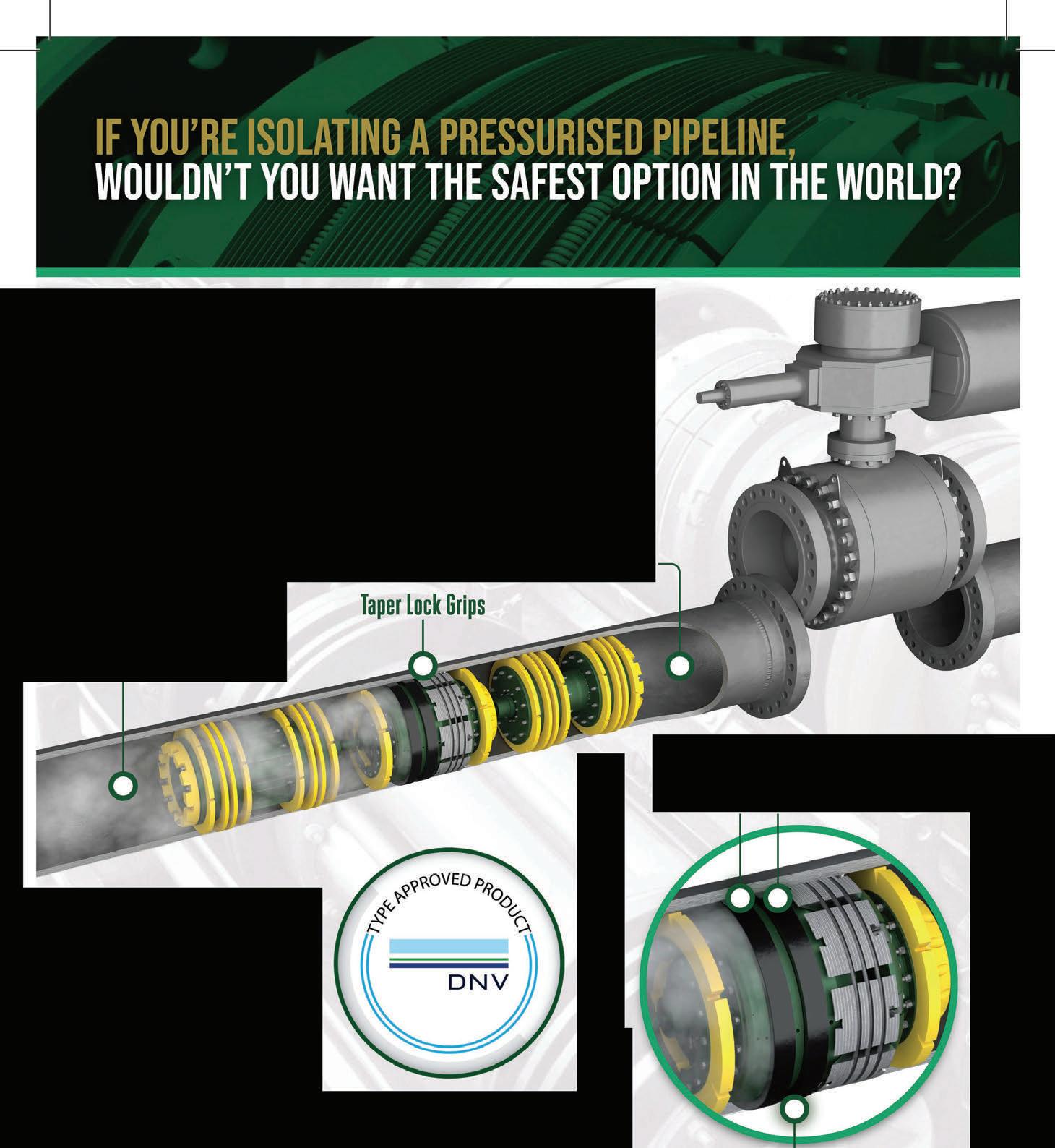


The Remote Tecno Plug ® provides fail-safe double block and monitored isolation of pressurised pipelines while the system remains live and at operating pressure.


As Australia prepares for future fuels including hydrogen, Future Fuels CRC researches the details that will make this transition a success.
Across the Australian industry’s research programs there are many research projects focussed on unlocking the speci c details that will make future fuels a reality.
Applications of hydrogen that involve combustion need to consider ame visibility. Being able to visually assess a ame has implications for operations and safety in any industrial, commercial or residential application. A pure hydrogen ame produces less visible light than a natural gas ame, yet in practice they are not invisible and salts and dust in the air often give the ame an orange colour. Our research is now identifying the limiting conditions which in uence hydrogen ame visibility under real-world conditions, and to what extent the environmental aspects a ect this visibility. is research is nding the variables that impact ame colour and which combination of variables leads to the best outcome for ame colour for aesthetic and safety purposes.
Ammonia transmission
Ammonia has great potential as a renewable energy carrier and fertiliser both within Australia and for export. is means we could soon see ammonia transmission pipelines in Australia, rather than the current ones that exist within industrial facilities. However, there is a lack of compiled data on risks and consequences for cross-country ammonia pipelines. Our research team is now reviewing
ammonia toxicity and dispersion behaviour and how this relates it to acceptable limits for human and environmental exposure. e project team are reviewing regulations and legislation for the design of ammonia pipelines to prevent leaks and ruptures and minimise consequences using e ective mitigation strategies. Research has a huge role to play in the reduction of risk for this new industry, helping to de ne the vital details such as location relative to population, isolation valve spacing and automation, leak detection requirements and emergency response processes.
Plastic distribution networks could have a major role to play in the future distribution of hydrogen. In plastics networks squeezing the pipe to temporarily close it is a routine operation, but the current use of re-rounding clamps to extend the lifetime of a pipe with a squeeze o is not completely understood. e mechanism by which the clamp extends the life is not well understood nor is the extension of life the clamp provides. Certain variables including the age of the pipe and the type of clamp need to be better understood. Deakin University’s research team is now assessing available clamp methods and associated life expectancy to help industry better understand this issue in detail.




to hydrogen and future fuels. e RMIT research team have been working to evaluate di erent professional learning experiences for safety. ey are already holding training workshops with pipeline engineers from March to May 2025 that use a serious game called Planet Pipeline to put pipeline engineers into real-life situations to develop their decision-making skills. Engineers will play the serious game in small groups with a debrief and replays encouraged to test alternative outcomes.
e game covers three scenarios:
• Making design and operating choices to manage the threat of third-party damage to a pipeline.
• Make design choices regarding oods and work with a landowner who doesn’t want a pipeline running through their agricultural land.
• Exploring decisions on defects in an operational pipeline that requires a welded repair.
e results from these workshops will inform professional learning modules that the APGA plan to deliver to develop excellence in engineering professional practice.
All of these research projects are available to our industry participants on our website at futurefuelscrc.com along with our webinars and events, and Future Fuels CRC looks forward to sharing more of our research to enable hydrogen and biomethane in Australia.








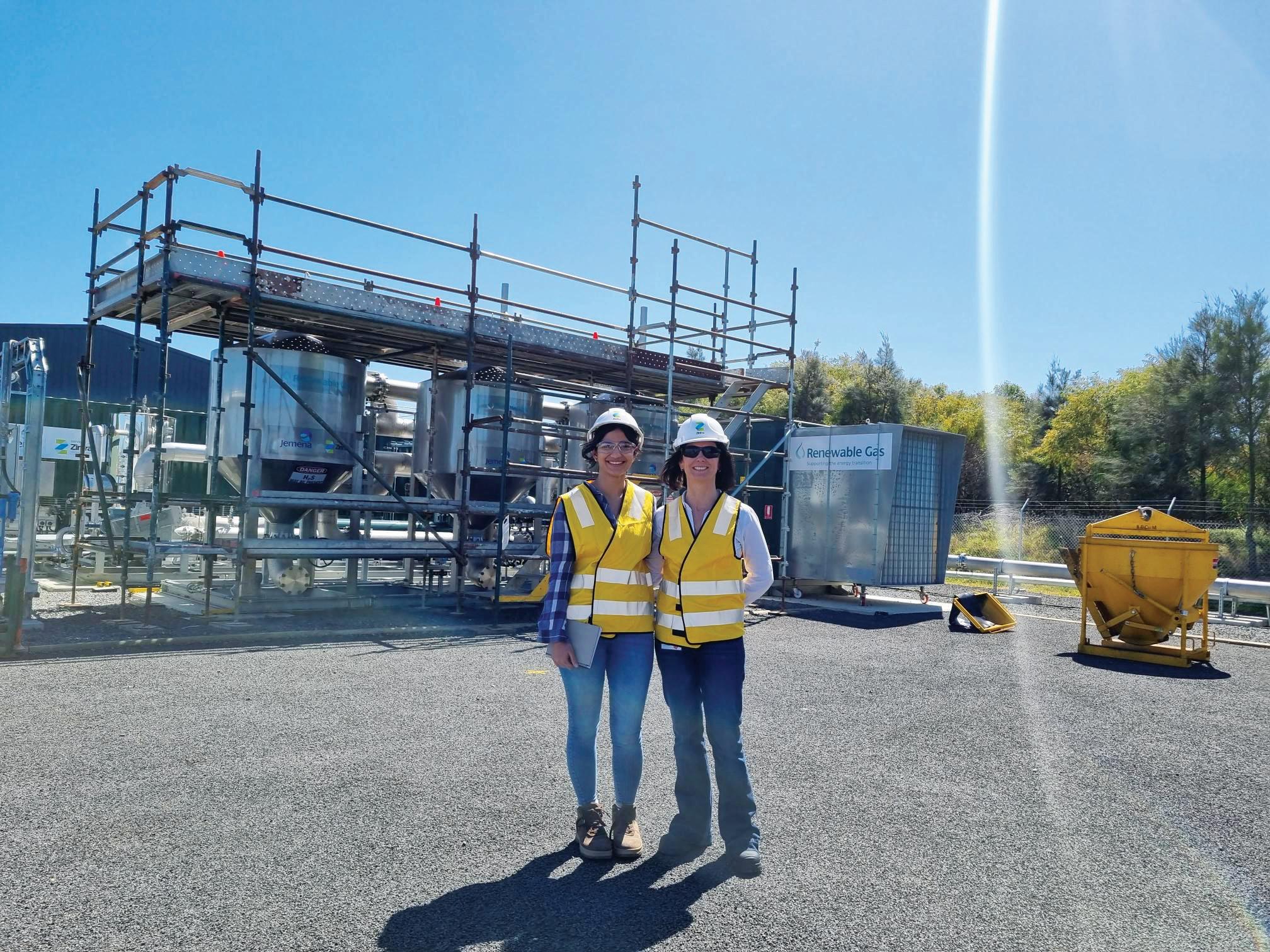
Women in Pipeline Forum (WPF) hosted a site visit to the Jemena Malabar injection plant, o ering a tangible glimpse into one of the opportunities future fuels presents. e project demonstrates the process of upgrading biogas produced by Sydney Water to biomethane for injection into the gas network.
Lunn caught up with one of the attendees, APA Future Fuels analyst Vaish Kala, within the Path nder team, for her thoughts on the site visit, her role and how future fuels are already changing the industry.
What did you like about the Malabar plant? It was great to see how biomethane is already playing a role in decarbonising the gas network. It’s really inspiring to see an end result of concepts that are always talked about.
What’s your team role within future fuels?
e role of the team is to ensure the possible medium to long term future directions of the
might be next and why current focus areas may need new direction.
What’s your role within the team?
I initially joined the team as Future Energy Graduate and later returned as a Hydrogen and Future Fuels Analyst, having completed my graduate program. My current role centres on project development and delivery. It’s a fascinating blend of commercial acumen, technical expertise, and stakeholder engagement.
Although, I believe one of the crucial components for our team is to ‘bring people along the journey both within our organisation and externally - be it from a knowledge sharing perspective or a social license forefront.’
What excites you about working in future fuels?
e sector itself is transforming while grappling with the need to balance energy security, a ordability and reliability. It provides
been amazing.
e importance of showing what’s already happening with clean energy within the industry cannot be underestimated. rough site visits and events spotlighting projects, we can engage both industry insiders and external stakeholders in this journey. By actively involving young people in these initiatives, they o er a rsthand glimpse into the future of the industry, inspiring them and providing avenues for their involvement in shaping tomorrow's energy landscape.
Two site visits are being hosted in May 2024 by the Young Pipeliners Forum and APGA to two di erent projects, both contributing to the changing energy mix. ese are Hydrogen Park in South Australia (AGIG) and the Kurri Kurri Lateral Pipeline Project in Newcastle (APA). I’m looking forward to hearing from everyone attending these events and hosting events throughout the year.

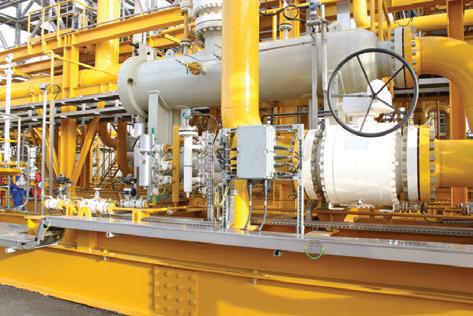
The most e ective method to maintain and improve safety and reliability of pipeline ball valves is routine lubrication using a proven valve lubricant along with a preventative maintenance scheme will ensure optimum valve operation.
The DSI range of lubricants, sealant and flush are being used throughout the Pipeline industry in all states within Australia.
All ACC’s DSI products are supplied by a company that is a leader in the manufacture of lubricant since 1968.




Explore the company's recent project history in pictures.
Nacap has long been at the forefront of the pipeline industry for many decades. Today, it is recognised as a versatile energy infrastructure contractor, encompassing a wide range of projects ranging from complex transmission pipelines to wind farms and infrastructure in defence, water and mining across Australia, Papua New Guinea, and South East Asia.
Nacap President Matthew O'Connell emphasised the company's remarkable legacy and steadfast dedication.
“As a specialist energy solutions provider, Nacap is underpinned by a commitment to delivering our clients safe, reliable and robust solutions for powering communities,” he said.
“Our team is renowned as much for our capacity to form professional, mutually bene cial long-term partnerships as we are for our values: integrity, teamwork, and striving to be better.”
e company’s expertise spans the oil and gas, power transmission, renewable energy, defence, mining, and water sectors, encompassing everything from pioneering power generation solutions to major pipelines and networks.
e company also provides civil construction for complex infrastructure projects.
Nacap stands as a respected energy contractor within the Australian, Papua New Guinea and South East Asian pipeline industry, catering to major asset owners and prominent multinational organisations in sectors like liqui ed natural gas, oil, gas, water, and mining.
e company’s commitment to
innovation, safety, and excellence paves the way for a promising future.
And as the team looks ahead, Nacap is unwavering in its dedication to investing in the energy transition, with a vision to build a better, more sustainable future for all.
O’Connell rea rmed Nacap’s commitment to investing in new innovations and technology:
"We continuously re ne and enhance our resource strategies to ensure the highest standards of quality and safety,” he said. "Our aim is to e ciently and reliably deliver resources while contributing to the global transition towards sustainable energy for a better future.”
Nacap respects cultural heritages and works cooperatively with landowners to deliver successful outcomes for projects.
“Social license is integral to every facet of our operations,” O’Connell said.
“Our deep-rooted commitment to respecting both people and the land is evident in our longstanding support for First Nations Australian participation and reconciliation.
“Our genuine concern for the welfare of our communities, and our proactive approach to pioneering tomorrow’s energy infrastructure today.”
O’Connell said he has always taken an immense pride in the Nacap team who bring the company’s values to life, and who are the backbone of its success.
One of Nacap’s recent project for Jemena/Zinfra, Port Kembla Gas Pipeline. Nacap successfully delivered an ECI scope to de-risk and optimise, followed by the construction scope. Project located in Wollongong NSW.


company


In a commitment to harnessing renewable energy sources, Nacap’s comprehensive services encompass the cutting-edge construction of wind farms, battery storage solutions, and the advancement of thermal energy systems.



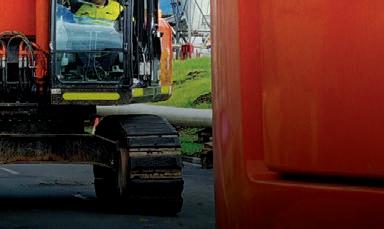

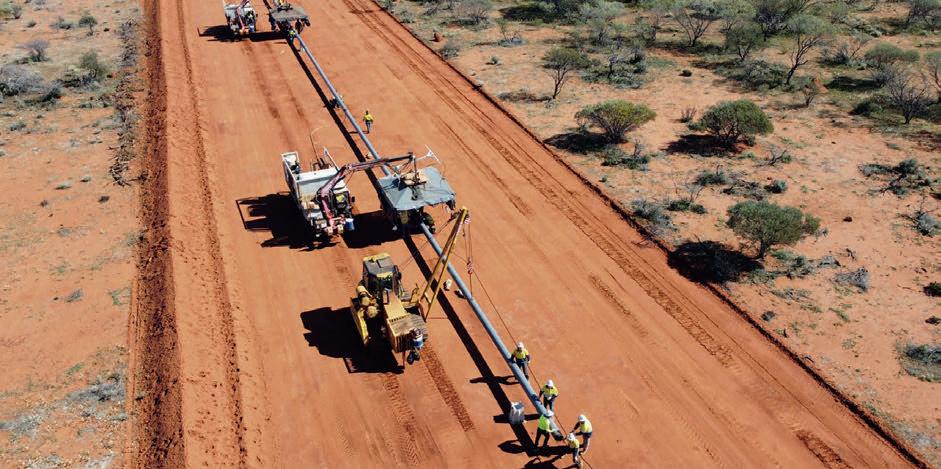
Nacap’s recent 580km major gas pipeline project for APA in Western Australia, Northern Gold elds Interconnect Pipeline.

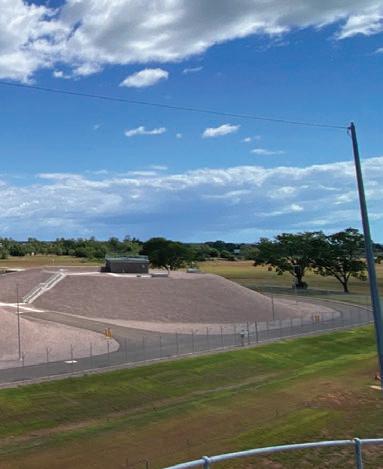
Nacap delivers complete program of gathering network infrastructure with expertise including access tracks, civil well sites, gas and water pipeline gathering networks in Australia and PNG.





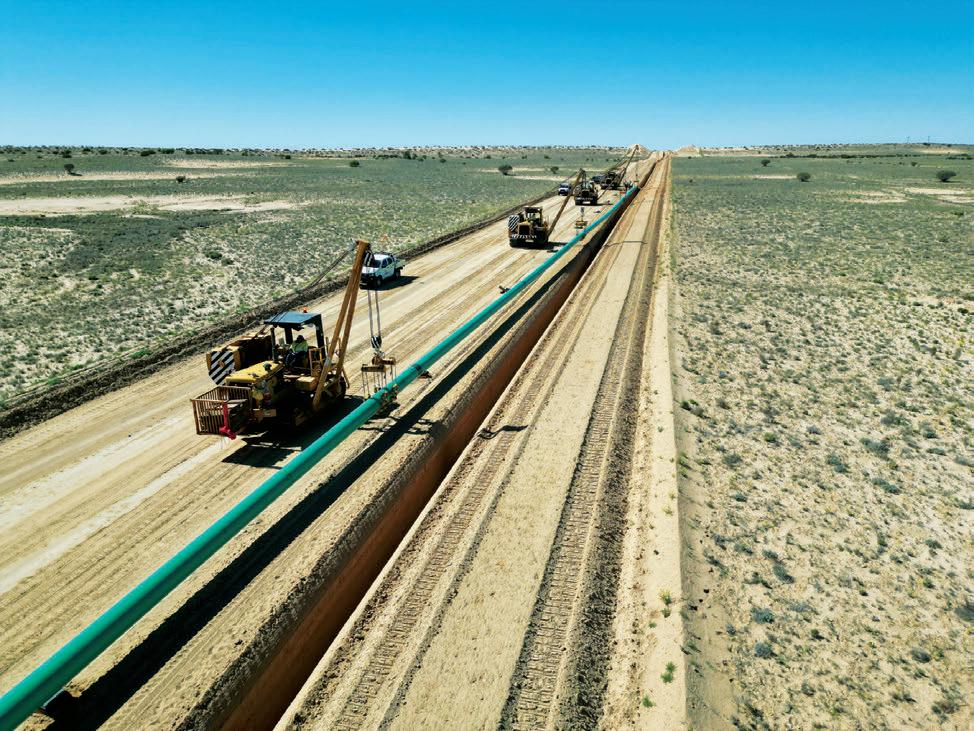
Another recent gas pipeline project in Moomba for Santos. The project included close collaboration with Santos and their engineering team to support construction optimisation and delivery timelines.
Nacap’s recent gas pipeline project for Beach Energy, Enterprise gas pipeline in South-West Victoria including the construction of gas and mono-ethelyene glycole pipelines.

Discover how Bridger Photonics’ new technologies enables navigation of emissions reduction challenges.
At the core of Australasia's oil and gas industry lies a critical task: the reduction of methane emissions across the entire value chain.
Emission reductions are important due to the strong global warming potential of methane, and oil and gas resources present accessible mitigation opportunities to assist.
From remote gas elds to extensive pipeline networks and liqui ed natural gas (LNG) facilities, every part of the industry is committed to confronting this challenge head-on. Balancing energy demands with emission reduction goals is a complex task, and operators across the globe face similar challenges.
One such way that has emerged to help operators face this challenge is a growing eld of emissions detection technology.
e eld of emissions detection has experienced rapid advancements in technology in recent years, growing beyond hand-held cameras and site visits to state-of-the-art sensors ying over sites that help operators more e ciently reduce methane emissions.
Challenges for emissions reduction across various parts of the oil and gas industry vary, and each sector faces its own unique challenges.
Production facilities are spread across a wide
geographic area, are intermingled with other methane sources, consist of many di erent types of equipment and various potential leak sources on each facility.
Until recently, it has been di cult to e ciently detect and attribute methane emissions to a speci c equipment type and from individual sources. Plumes that are lumped together as one from technologies with inadequate resolution may be misleading, creating the illusion of a single, larger leak, when several smaller leaks are present.
Adequate localisation and attribution of emissions to distinguish from nearby sources, along with the proper emission rate detection sensitivity (i.e. the leak size that is consistently detected by a technology), are key elements to gaining meaningful information about production site leaks.
Pipeline infrastructure covers tens of thousands of kilometres, can go across land owned by a third-party or through a shared right-of-way, can run below roadways, waterways, and other obstacles. Additionally, the access and ability to survey the entirety of an operator’s pipeline infrastructure combined with the proximity to cities, homes, or other civilian areas has historically made scanning for leaks di cult.
Popular emissions reporting frameworks like
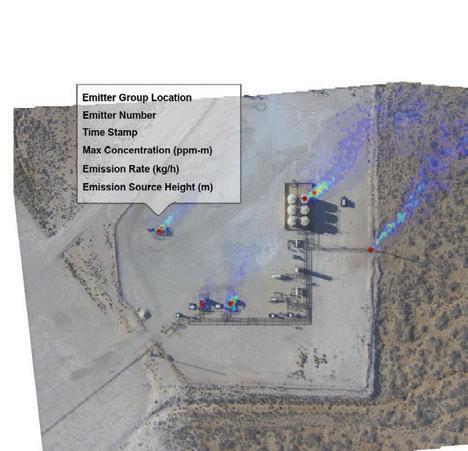
Oil and Gas Methane Partnership 2.0 (OGMP 2.0) require transparency and accountability in reduction e orts. Additionally, Bridger Photonics continues to see regulations evolve locally and across the globe, requiring highaccuracy top-down measurements, all underscoring the need for reliable and accurate data.
Despite these challenges, innovative solutions that have been rigorously vetted on other continents by oil and gas multi-nationals o er promising avenues for enhancing emissions monitoring and mitigation e orts.
Innovation has always been the driving force behind progress, and this adage holds true for emissions detection. roughout North and South America, Bridger Photonics’ aerial Gas Mapping LiDAR™ (GML) technology has been widely adopted as the market leader for emissions detection across the entire natural gas value chain.
Household names like Chevron, ExxonMobil, Cheniere, and Phillips 66 have adopted the technology, along with dozens of mid-sized and smaller operators, many after trialing several technologies.
Chevron’s Americas president of Exploration and Production Bruce Niemeyer described the





company’s experience using aerial GML technology as a “gamechanger”.
“It can nd leaks that are 10 times smaller than other commercial providers are capable of spotting,” Niemeyer said.
GML sensors are deployed on small aircraft - xed-wing or rotary-wing - and scan hundreds of production sites, or hundreds of kilometres of pipeline in a single day.
Gathering lines, gas processing plants, and LNG facilities can also be monitored with unprecedented speed and accuracy. Companies whose assets span the value chain can utilise a single technology to unify their data collection and analysis.
e laser mapping techniques used by GML pinpoint leak sources down to the equipmentlevel, so crews can go directly to a detected leak without the need to search around a facility, thereby reducing both vehicle and foot tra c, and utilising personnel resources more e ciently.
Aerial photography captured during the scans o ers valuable context for understanding
Gas Mapping LiDAR sensors are attached to small aircrafts and scan hundreds of production facilities or hundreds of kilometres of pipeline per day.
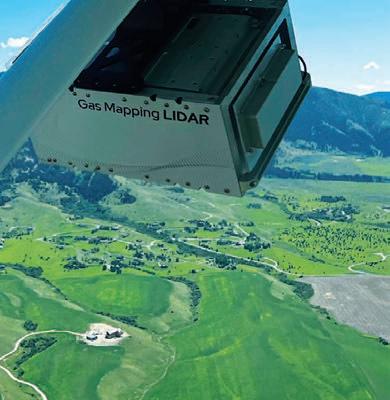
activities at the facility. Emission rate quanti cation helps repair crews prioritise based on the relative size of emissions. GML's easy-tounderstand maps and data allow crews to clearly see the sources - without any doubt.
Having the most accurate information available becomes crucial for e ective emissions reduction, baselining, and reconciliation. e integration of advanced technologies like GML, capable of providing comprehensive and accurate emission data at scale, becomes increasingly vital for operators striving to reduce emissions, meet regulatory requirements, and adhere to reporting frameworks like OGMP 2.0.
e oil and gas industry in Australasia is facing the monumental task of reducing methane emissions across every facet of the value chain. Amid this challenge lies an opportunity to utilise market-proven innovative technologies that have been widely validated and adopted on other continents by industry-leading operators.

GML is exceptionally positioned to support Australia’s unique oil and gas industry, from remote infrastructure crossing harsh environments, to its most complex facilities where safety is paramount. By deploying advanced technologies like GML, the industry can scan vast expanses of production sites and pipelines with unprecedented speed and accuracy, pinpointing emission sources down to the equipment level.
is strategic utilisation of innovative solutions not only enhances operational e ciency but also reinforces the industry's commitment to emissions reduction.
With lessons learned and technologies re ned through global implementation, the time is ripe for embracing these advancements and ushering in a new era of emissions reduction in the region.
With Bridger Photonics slated to begin scans in Australia this autumn, the industry is well poised to bene t from cutting-edge tools and expertise in methane emissions detection and reduction.
Heath Services and Bureau Veritas Australia are together working with Australian gas suppliers to discover a true measure of fugitive emission losses, utilising state of the art equipment to directly measure samples and report via innovative new software for improved analysis.

Currently, for Australian providers, committing to e Oil & Gas Methane Partnership 2.0 (OGMP 2.0) framework is voluntary.
e OGMP 2.0 is the United Nations Environment Program’s agship oil and gas reporting and mitigation program.
It is the only comprehensive, measurement-based reporting framework for the oil and gas industry that improves the accuracy and transparency of methane emissions reporting, according to the United Nations, and is key to prioritising methane mitigation actions in the sector.
However the European Union (EU) proposes to introduce new legislation, and the rest of the world is likely to follow.
is new mandatory EU legislation proposed by the European Commission applies a time based OGMP 2.0 framework. is includes providing direction to oil and gas producers on monitoring and reporting, mitigation obligations, leak detection repair, venting and aring requirements.
Legislation requires that by 2027 all external oil and gas importers must also abide by the same regulations as EU producers.
Leading Australian exporters are anticipating the implementation of comparable regulations and

Large incompatible datasets from diverse origins produce complexities where amassed data is di cult to compare.
Leading methane emissions reduction strategies are incorporating digital platforms, understanding that creating a harmonised approach for global emission calculations removes variances originating in local regulatory frameworks.
Bureau Veritas is a recognised world leader in quantifying greenhouse gas emissions and providing unbiased third-party compliant emission reporting.
Bureau Veritas is working with Australian clients to combine the data that Heath are collecting, the multiple levels of the OGMP 2.0 reporting framework, and the Australia’s National Greenhouse and Energy Reporting Scheme.
e unique BV EmissionView dashboard combines multiple reporting schemes into one easy
















































Safe and Effective Solutions for Rapid Pipe Testing & Repairs
Confidently test open-end pipe, pipelines & pressure vessels without welding, and isolate & test flange-to-pipe weld connections with GripTight Test & Isolation plugs from Curtiss-Wright.
• Patented gripper design for increased safety in high-pressure applications
• Eliminates welded end cap procedures for testing pipe spools & piping systems
• Test flange-to-pipe welds without pressurizing entire systems
• Isolate & monitor upstream pressure and vapors during hot work
• Standard pressure ratings up to 15,000 PsiG (1034 BarG)
• ASME PCC-2 Type I, III & IV testing devices










As the world grapples with the urgent need to reduce methane emissions, the role of gas networks cannot be overlooked. Picarro delivers a breakthrough solution with emissions360.
Through a measurement-informed emission inventory (MIEI), gas network operators can gain detailed insights into their emissions, helping them take an informed and proactive approach toward net zero goals.
Picarro's emissions360 platform provides reliable, data-driven insights into methane emissions across a gas network, enabling operators to identify, quantify, and reduce their environmental impact.
is platform o ers an advanced, scalable, and easy-to-use solution for managing emissions data.
Traditional inventory methods – which have been in place since the 1990s - often underestimate the actual emissions, primarily due to the reliance on generalized emission factors and lack of granularity.
On the other hand, an MIEI provides a comprehensive and accurate representation of a gas operator's emissions, identifying speci c areas of high emissions and opportunities for targeted mitigation.
e emissions360 platform takes emission management to another level. It analyses methane concentration data, wind data, and natural gas infrastructure data to locate, quantify, and visualise methane emissions.
With this tool, operators can identify leaks faster and prioritise their repair, helping them keep their networks safe, e cient, and environmentally compliant.
In the current regulatory landscape, having a clear understanding of one's emission inventory isn't just good for the environment; it is also good for business.
Regulators, environmental groups, and investors are increasingly demanding greater transparency and responsibility in emission management.
Gas networks across Australia have a critical role to play in reducing the country's methane emissions.
e value of a comprehensive, accurate emission inventory cannot be overstated.
With tools like Picarro’s emissions360, gas operators can maintain the integrity of their networks while taking a signi cant step toward a cleaner, more sustainable future.

The
e value of a Measurement-Informed Emission Inventory is immense. It empowers gas operators to transition from a reactive to a proactive approach in emission management. rough Picarro’s emissions360 platform, operators can gain precise, actionable insights that will help them improve safety, optimise operations, and signi cantly reduce their environmental footprint.
In the current era of energy transition, the demand for more sustainable and e cient energy solutions is paramount.
As natural gas operators navigate this evolving landscape, the key to long-term viability lies in aligning with emissions reduction, risk management, and ongoing value delivery.
Picarro, at the forefront of leak management and emissions reduction, enables operators to revolutionise their approach to risk management.
Its enterprise solution provides the necessary balance to e ectively lower emissions, optimise asset management, and cut costs, ensuring operators meet their goals within a uni ed framework.
In any gas network, a handful of critical leaks can signi cantly impact system risk, emissions, and public perception. With Picarro technology and analytics, operators can collect emissions data across the entire network, quantify emissions ow rates with unprecedented e ciency, and prioritise critical leaks.

is transformative approach provides operators with the most e ective tools to proactively manage leaks using a risk-based strategy, and embrace a structured, planned methodology.
It enables operators to holistically manage system risk as regulations evolve, and continuously assess and improve their gas system health and performance.
As the transformative force in gas distribution, Picarro delivers impactful, immediate enterprise value.
Collaborating with leading operators, its database of direct measurements and analytics set the industry’s benchmark.



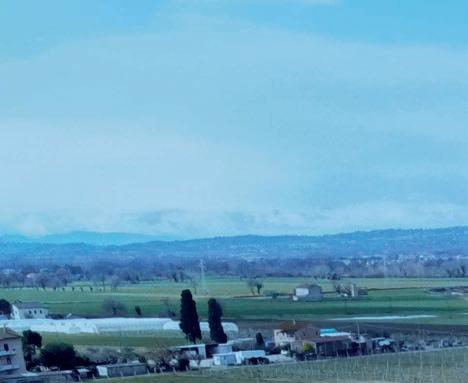





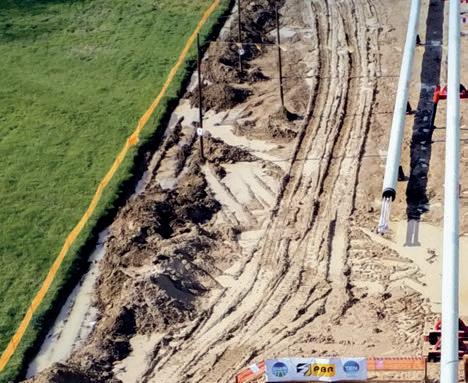
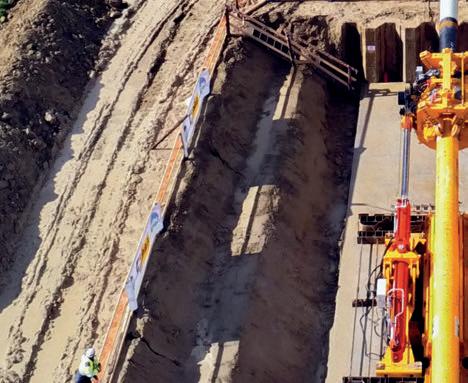





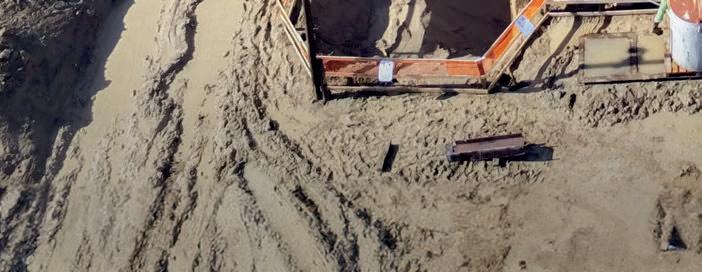


Emergency and temporary liquid transfers require robust and reliable equipment that is also sustainable. In an attempt to help protect the planet and people, Crusader Hose challenges the usage of single-use high density polyethylene poly pipe for pipelines.
Moving water or fuel from A to B requires e cient and safe execution for storage, distribution, acquisition, or transportation.
When planning temporary pipelines, beyond turning to familiar rigid systems, what is often overlooked is whether it best supports sustainability objectives in reducing singleuse plastics.
Crusader Hose, a manufacturer of lay at hose suitable for high-volume and high-pressure pumping applications, believes its reusable exible lay at pipeline solutions o er more environmental support than rigid poly.
Crusader Hose is an Australian company that has been manufacturing exible lay at hose for over 38 years and has gained a strong reputation for reliability, trust, and excellence.
It has strong connections with the mining, pump, and drilling industries as well as with the Australian Defence Force (ADF).
Crusader Hose Managing Director Francois Steverlynck said the company’s approach was unparalleled in the industry.
“For example, not only is our Waterlord lay at hose strong and robust, capable of withstanding pumping at 2000 kilopascals, we are con dent our lay at hose solution ticks many boxes when

build supports on uneven ground, their exible
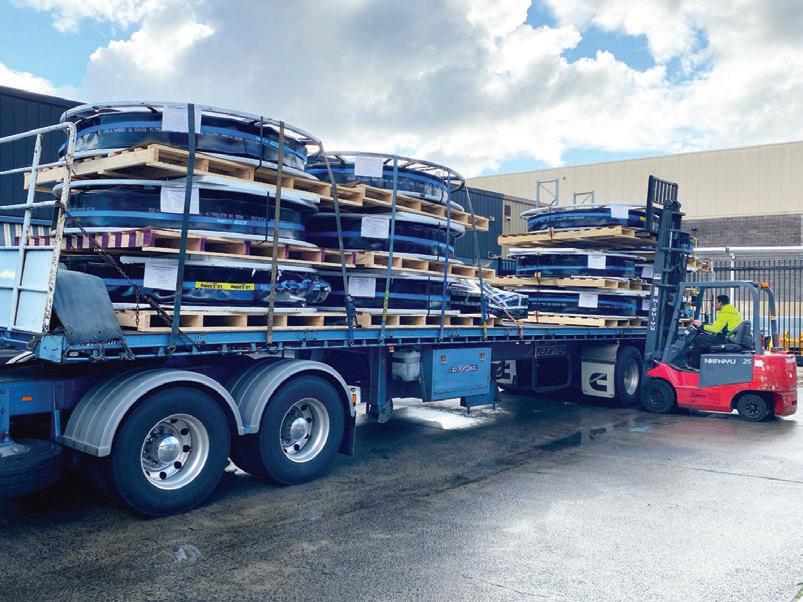
exible pipelines require far fewer trucks to transport the same length of rigid pipe. Fewer trucks on the road equals reduced CO2 emissions and cost savings.
Being easily reusable is a major rehabilitation bene t over poly pipe. When exible lay at pipelines are no longer needed, they can be easily retrieved with the reel systems.
ese pipelines can be either redeployed to their new location or stored for future projects. If managed properly, abandoned lay at hose lying around waiting to be dismantled and removed from the site will be non-existent in principle.
e reel systems also greatly reduce the need for manual handling and are key to the lay at hose system.
e most sought-after models are the Hamersley, Argyle, and Timor. Each system has its features and capabilities to satisfy a large range of demands.
Customised models have also been designed for several large-scale projects with the ADF, Taiwanese government, and South Korean Navy. eir large-diameter high-pressure Waterlord hose can pump up to 500 litres per second. With
up to 200m of lay at wound onto interchangeable reels, their reel systems can deploy pipelines in hours versus the days it would take to lay similar-length high density polyethylene (HDPE) pipelines.
With over 350 established mines across Australia, the Waterlord dewatering system may prove an advantage to many.
“Crusader Hose has worked with many mines from WA to Queensland and have supplied many hundreds of kilometres of lay at hose,” Steverlynck said.
“Our manufacturing and engineering expertise allows us to support this essential industry and other industries, too.”
Considering the critical elements of agility and speed, the ADF have been using Crusader Hose Petroline lay at hose and reel systems for over two decades.
Refuelling helicopters and fuel debunking need reliable and e cient systems.
With tested and tagged hose tted with couplings that won’t blow o under
pressure, the vital fuel supplies can be replenished with quick pipeline deployment up to 30km long. After the transfer, the reel system retrieves the pipeline until it is needed again.
Although lay at hose have been around for decades and proved itself a coste ective and eco-friendly solution, moving away from a rigid pipe system to using lay at requires con dence in Crusader Hose’s capability.
“For those water engineers who doubt the bene ts, bear in mind that the military also uses our hose for fuel pumping across seas and beaches,” Steverlynck said.
“We have created an extra dewatering option for the mining industry with our quality hose.”
Steverlynck said he was calling on the water management experts to consider all aspects of using exible lay at hose and reel systems, including transportation, handling, installing and rehabilitation costs, when planning liquid transfer systems.

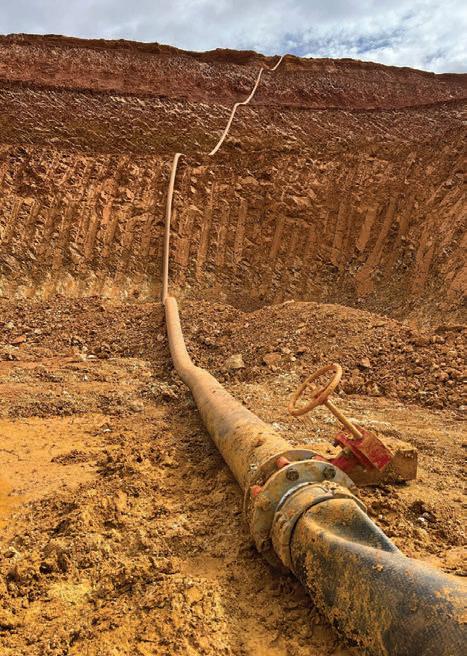








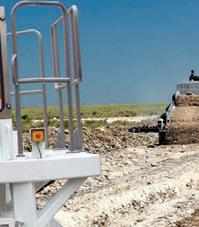


The Australian Pipeliner sat down with Global Pipeline Equipment's (GPE) Matt Dridan to discuss how companies, such as GPE and Pipeline Plant Hire, are optimising project delivery through matching equipment selection with requirements.

GDridan is adamant; ‘one size ts all’ doesn’t apply when it comes to nding the right equipment and machinery for a speci c project.
Can a project achieve desired production with a smaller machine, less transport cost, fuel burn, and hire cost?
e advantages of using vacuum lifts over conventional lifting equipment, such as cranes and slings, are common knowledge now.
Vacuum lifts are one clear case of not just a major improvement to productivity, but also a massive improvement in risk aversion to both personnel and product.
What is less obvious, are the advantages of one vaclift setup over another.
What are the main considerations for a project to contemplate when selecting a vacuum lift?
e tare weight, or unladen weight, of both the host machine and the vacuum lift attachment.
is is a very important point to consider. Not only do you have the additional hire costs of an oversize machine, but there is also the additional transport, fuel, and serving costs to consider.
Especially when some projects require multiple freight movements over the course of the job. Pipeline Plant Hire (PPH) has dedicated both many years, and great expense to maximise the e ciency in these areas.
consider. is is animportant consideration, especially when working in remote locations.
e last thing a project wants is a bunch of trucks lined up, waiting to be unloaded, because of some over complicated gadget spitting the dummy. e secret to any great design is simplicity. e more layers of electronics and sensors, the more potential problems they create.
And you then need to have especially quali ed service people on hand to rectify the matter. is is not exactly an option in remote areas, and often with limited comms.
Again, simplicity in design is what has underpinned PPH’s long standing success in
supplying vacuum lifts to the pipeline industry.
Finally, take into account the experience. e importance of selecting the correct equipment for lifting operations, cannot be overstated.
ere are many considerations involved when selecting vacuum lifting equipment, including: product static and dynamic exibility, protective coating texture, and mechanical seal assembly forces required.
PPH has a long-standing reputation in his area. We have been supplying this technology since well before the mining boom. And our record in this area speaks for itself. Trial and error in lifting equipment, is not an option.
Do you have example of a project answering this criteria in mind?
For more than a decade major pipeline projects in Australia have been safely completed using PPH vacuum lifts.
is has included Queensland projects: Australia Paci c LNG, Gladstone LNG and Queensland Curtis LNG. ey were successfully completed using our vacuum lifting technologies, whereas existing alternatives at the time would have cost upwards of 30 per cent more, in both transport and hire costs.
PPH was able to use its 36t and 47t machines, coupled with our integrated vacuum lifting systems, to provide the heavy pipe handling solution. On top of this, our PL1500 quick-hitch vacuum lifts provide an e cient method of pipe handling on smaller projects by utilising the projects’ own diggers as host machines.


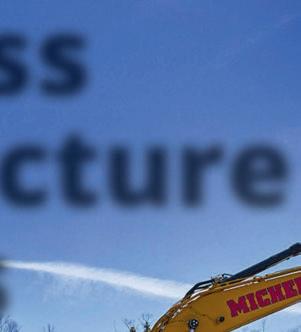



Horizontal Directional Drilling
• Multiple NASTT Project of the Year awards
• Australia-based operations with local resources
• Extensive experience with intersects and long crossings
• Successful 4.7km HDD under waterway
Direct Pipe
• Foremost Direct Pipe Contractor
• Outfalls and shore approaches
• Pipe Installations up to 1.5m
• Completed first of multiple 2,250m HDD’s with 590m elevation change
Longest HDD intersect completed in Australia
Record breaking HDD for combined elevation change and length


In the dynamic landscape of stormwater management, Iplex is breaking new ground with larger BlackMAX® stormwater pipes hitting the market.
Designed to exceed industry standards and set new benchmarks in quality and performance, BlackMAX stands as a testament to engineering excellence.
Iplex Technical Product Manager, Michael Lancuba reinforced the quality and performance .
“Our BlackMAX pipes are renowned for their durability and e ciency, and we are happy to announce that they are now available to order in larger diameters, including DN750, DN900, DN1000, and DN1200,” he said.
“ is expansion represents a signi cant leap forward in engineering possibilities, o ering engineers and industry leaders exibility in designing and implementing stormwater systems.”
e product is now available to order in larger diameters, doubling the range of what was previously available, making it the stormwater solution that makes sense.
“With our new expanded range of larger diameters and a commitment to excellence, BlackMAX is the de nitive choice for futureproo ng infrastructure projects and ensuring long-term success in stormwater management,” Lancuba said.
BlackMAX encompasses many features:
• An enhanced capacity and performance: e introduction of larger diameters means increased stormwater carrying capacity. is may translate to improved system performance, reduced risk of ooding, and better resilience against heavy rainfall events, crucial factors in ensuring e ective stormwater management.
• A greater design exibility: With a wider range of diameters to choose from, engineers have more options for designing tailored stormwater solutions. e versatility of BlackMAX allows for e cient customisation to meet speci c project requirements, whether it is for urban drainage, industrial sites, or infrastructure developments.
• Streamlined installations: e larger diameter BlackMAX pipes streamline the installation process by reducing the number of joints and ttings required. is not only simpli es construction but also minimises potential points of failure, leading to more robust and reliable stormwater systems.
• Cost-e ective solutions: Despite the increased capacity, BlackMAX remains a cost-e ective choice for stormwater infrastructure. Its



lightweight yet durable construction contributes to lower transportation and installation costs while ensuring long-term performance and minimal maintenance expenses.
“We are working every week with forward looking customers who are choosing plastic pipe options, and we are proud to be able to give our customers a larger range when it comes to sizes,” Lancuba said.
“We know polypropylene pipes o er several advantages over conventional pipes, especially in certain applications and environments.”
BlackMAX is crafted from structured wall polypropylene, and all Iplex pipes and ttings are meticulously engineered to withstand the rigors of non-pressurised gravity drainage systems. e result is a durable, e cient, and sustainable solution that stands the test of time.
Ensuring durable stormwater management pipes is crucial for infrastructure longevity.
BlackMAX o ers enduring stormwater solutions for future generations, with a service life of over 100 years when designed and installed in accordance with the relevant standards and manufacturers advice.
Requiring minimal maintenance compared to
conventional pipes, the pipes are less prone to scaling, rusting, and other issues that can a ect the performance of pipes. is product requires less energy to transport, contributing to sustainability goals.
BlackMAX bene ts from the material’s durability and high sti ness, making it structurally robust while maintaining lightweight properties.
It o ers superior hydraulic capacity, facilitating e cient ow and minimising the risk of deposit formation. is is especially bene cial for stormwater management systems where e cient water ow is crucial.
BlackMAX also o ers exibility and ease of installation across a range of environments. ey are available in a wide range of sizes and ttings, enabling swift and adaptable design con gurations for e cient stormwater drainage solutions.
ey are signi cantly lighter than conventional pipes, making them easier to handle, transport, and install.
is can result in reduced labour costs and faster and safer installation times and with rising



concerns surrounding the health and wellness of Australian construction workers, BlackMAX puts safety rst.
e lightweight nature of BlackMAX pipes means fewer hazards posed during transport and on-site movement, reducing the potential risk of accidents and injuries.
For more information, visit iplex.com.au
With more than 85 years of experience, Iplex is one of the original Australian manufacturers of large bore, twin-wall polypropylene pipes. e company’s technical engineers o er expert guidance and support for project success, ensuring reliability and professional support for stakeholders.
» Quality and collaborative HDD design and construct services
» Expertise to advise at the right time in the project delivery cycle
» Gas, water and sewer, rail, road, power, telecommunications, mining, residential development, renewables and hydrogen
» Maxi-rigs capable of long and wide diameter bores in hard rock and difficult conditions
» Building a future we all look forward to


Contracting company Rob Carr turned to kwik-ZIP for its project in Gosnells, Western Australia, and used its spacers to facilitate the slip-lining of a wastewater pressure main.
kwik-ZIP’s DNA is made up of versatility, simple installation and ease of use for contractors.
And it was because of these traits that contracting company Rob Carr turned to kwikZIP for its project in Gosnells, Western Australia.
e kwik-ZIP HDXT-103 spacers were installed to facilitate the slip-lining of a mild steel cement mortar lined (MSCL) wastewater pressure main into a RC Jacking pipe, running under a rail line for the Gosnells Main Pumping Station Wastewater Pressure Main Realignment project.
Rob Carr Project Manager Marie Piette saluted kwik-ZIP and its innovative spacers.
“ e MSCL pipes insertion is making good progress despite a challenging environment, with production e ciency notably enhanced by the simplicity of installation of the kwik-Zip spacers,” Piette said.
e simple and e cient installation process did not require any special tools or any requirement to pre-wrap the pipe.
kwik-ZIP spacers have no metal parts and are made from the company’s engineered thermoplastic blend with high exural strength, high temperature resistance, low co-e cient of
friction, abrasion resistance and outstanding chemical resistance.
With integrated rubber grip pads under collars to prevent slippage, kwik-ZIP spacers load sharing suspension system allows heavy loads to be shared across multiple runners.
is reduces point loading and increases the overall load capacity of the spacer.
kwik-ZIP’s series of spacers caters to a range of carrier and casing pipe size combinations. It also provides contractors and installers exibility to deal with project alterations.
In Australia, kwik-ZIP’s HDXT and HDX Series spacers have been successfully appraised by the Water Services Association of Australia (WSAA) against the requirements of WSAA product speci cation number PS-324 (casing spacers).
e WSA PS-324 product speci cation prescribes casings spacer requirements for correct protection of carrier pipes when installed inside casings.
kwik-ZIP’s rm presence in the industry has come about through years of hard work. e company was established in 2000, following the development of the industry’s rst patented nonmetallic plastic bow spring centralisers.

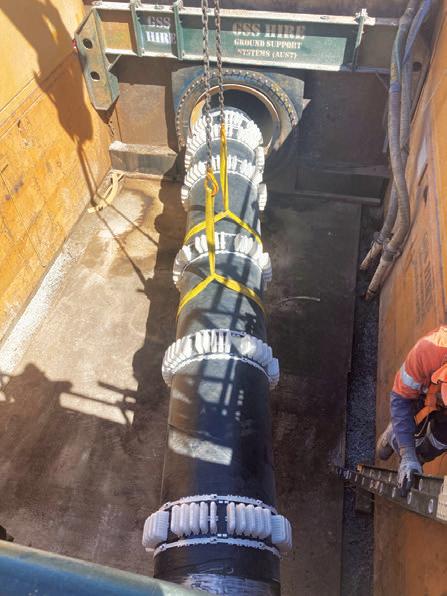
Since then, kwik-ZIP spacers have been making waves in the industry, and the company has been producing and marketing centraliser and spacer products for wider use.
Over the years, the kwik-ZIP team has developed and been awarded patents on various other centraliser and spacer products for applications in many industries, from production drilling to trenchless pipeline installations.
Today, kwik-ZIP manufactures and supplies a centraliser and spacer system for a wide range of industry sectors including production well drilling, trenchless pipelines, horizontal directional drilling, ground engineering and the general civil and construction markets.
Like all of its products, the HDX/HDXT spacer system series are aligned with the kwikZIP’s ethos to provide simple, cost-e ective, and high-quality solutions.
“kwik-ZIP is proud to be supplying products to such a well-respected Australian business in Rob Carr,” kwik-ZIP General Manager Paul Je reys said.
“Rob Carr is considered one of the pioneers in microtunnelling in Australia and a leader in utilities infrastructure construction.”
With our team of thought leaders specialized in emerging fuels, we serve as your capable partner in advancing your path through the energy transition. Four decades of experience in pipeline integrity management, own testing capabilities and a unique data pool are the basis for unparalleled integrity and risk assessments for the seamless integration of emerging fuels into your asset base. Choose ROSEN for the technology and competence needed to navigate the challenges of tomorrow’s energy landscape. www.rosen-group.com/hydrogen


When it comes to safeguarding oil and gas infrastructure, ACC Corporate leads the charge with tailored pipeline maintenance services.
Building on its foundations rst formed in 1992, ACC Corporate’s product range has grown to encompass valve service products, grease injection pumps and valve ttings.
For over 30 years, ACC Corporate has catered for the o shore market, providing lubricants, sealant, grease ttings and grease injection pumps for pipeline operators.
rough this extensive experience, the company has proven that regular lubrication of pipeline valves will allow the valves to function correctly.
One speci c product that has proved popular among pipeline operators is the grease gun, which is available as hydraulic foot-operated and air operated.
e ACC hydraulic foot-operated grease injection fun is an easy-to-operate and lightweight unit that provides an extremely fast discharge rate.
e product is ideal for situations where compressed air is not available and comes complete with an aluminium frame, a 10,000PSI hydraulic pump and a ‘J’ or ‘K’ grease stick barrel.
A versatile unit, the pump works well in o shore and onshore projects and is recommended for eld, plant, and platform applications.
e air operated grease gun is also lightweight and provides ease to operators with its fast discharge rate.
is pump also comes with an aluminium frame, a 10,000PSI hydraulic pump, a ‘J’ or ‘K’ grease stick barrel and a carrying case.
Also recommended for o shore and onshore projects, the air operated grease gun is designed to pump standard and special materials including lubricants, sealants, packing and cleaners.

on pipelines and wellheads, with many Australian pipeline service companies using both products.
As the company has evolved its product o ering, so too has its ability to provide personnel to conduct on-site valve maintenance.
ACC Corporate technicians can ease pipeline operators minds by conducting integrity checks.
Each ACC technician has training to identify faults and provide solutions to ensure the pipeline valves are fully functional.
is includes testing of valve seats and cycling operations.
To assist in the maintenance of the pipeline valves, ACC Corporate has several products perfect for the job.
e company’s range of valve ush, lubricants
and sealing qualities for pipeline ball valves.
With a focus on providing e cient support services for its customers, ACC also provides a 24/7 phone service for eld technicians to discuss any speci c issue and seek assistance from ACC personnel.
Expanding on this, ACC Corporate prioritises safety and implements various initiatives to minimise risks.
ese include utilising an online integrated management system to log risks and improvements, implementing online health and safety e-learning modules, electing a Health and Safety Representative to be the voice of its workers, a drug and alcohol testing program and safety refreshers at all sta meetings.
With its number one goal to meet client objectives, the company follows strict quality and conformance checks on all projects and follows recommended guidelines.


roughout its journey over the last 30 years, ACC Corporate has developed its highly experienced team of professionals to ensure the e ective development and management of its products and services.
e company prides itself on its fast response to demands and ability to adapt its o erings to comply with the various complexity of di erent client requirements.
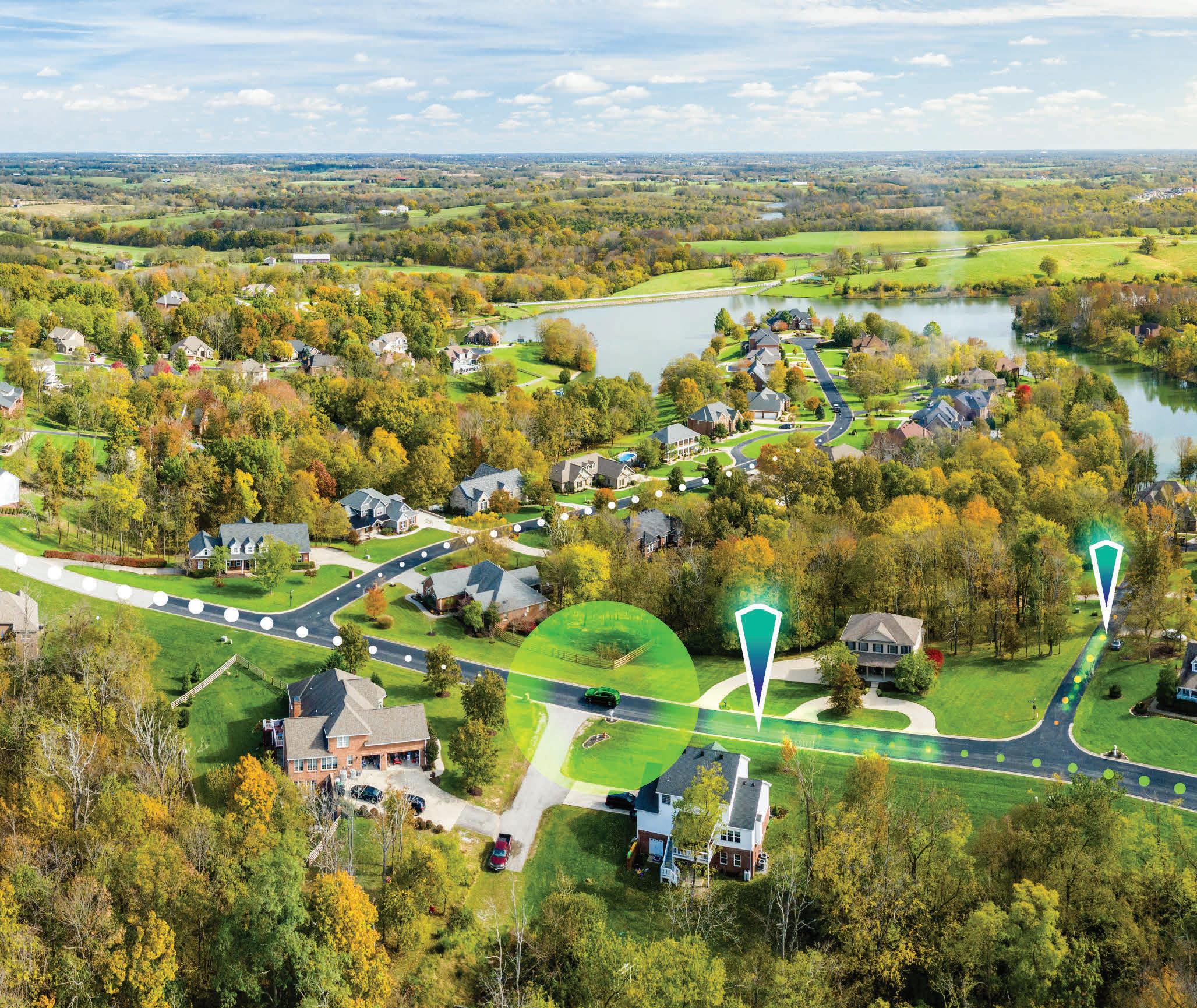

















































































When it comes to providing hot tapping and line isolation services in the Australian pipeline industry, Pro Pipe Services provides customers with unparalleled service excellence.
Pro Pipe Services’ Director Joe Buttigieg is con dent all of his customers have a 100 per cent success rate thanks to the work the company provides.
Since its inception in 2018 into the pipeline industry, Pro Pipe Services has prided itself on the quality of its service excellence it upholds.
“Our strength is the rsthand knowledge our team has in the pipeline industry,” Buttigieg said.
“While we have a small workforce, all our sta have had numerous years working in the industry.”
Buttigieg said that the company’s strength lies in being an Australian-owned company, and having locally based technicians.
“ is means we understand the requirements of our customers,” he said.
“Our customers can be rest assured knowing that all our eld sta and technicians are trained to the highest Australian standards and competencies.”
He also noted that having a local base means the company can react to its customers’ needs as quickly as possible, without the need to rely on technicians from abroad.
A testament to this is the substantial growth Pro Pipe Services has encountered since its inception.
“Originally, our operational service was in Victoria only, however, we are now constantly executing hot tapping, line Isolation and pipeline services right across Australia - from the east coast to the west coast, on shore and o shore,” Buttigieg said.
“While natural gas pipelines are the predominant product we work on, we have also executed work on hydrocarbons, water and other pipeline products.”
Recently, Pro Pipe Services completed two 34-inch (DN850) high pressure hot tap and line isolations for the installation of two new line valves for a major project.
e project was executed in a remote part of Australia, so logistically it was tough.
Moving equipment of that size to a remote location provided its challenges due to ooding and road closures. However, the job was completed on time, safely and awlessly.
e company backed that job up the following week by undertaking a 20-inch (DN500) isolation for a major pipeline project in Victoria.
Pro Pipe Services conducts hot tapping and line isolation services almost on a daily basis.
Based in Victoria, Pro Pipe Services executes hot tapping, line isolation and pipeline services across Australia.
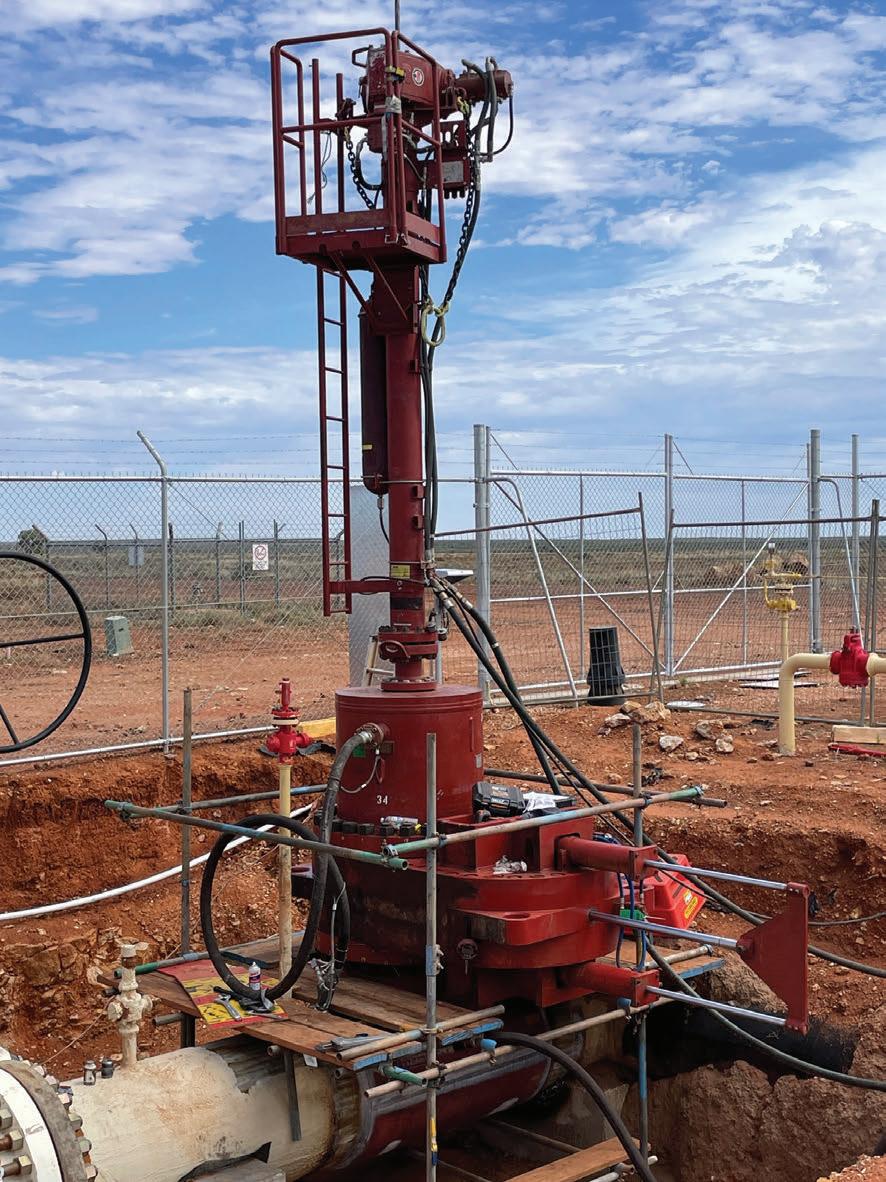
Whether it’s a high-pressure gas pipeline or lowpressure water line, on steel or polyethylene, Pro Pipe Services has the knowledge and experience to execute any job. No job is too big or small.
When it comes to providing hot tapping and line isolation services, the company uses proven technology that has stood the test of time.
T.D Williamson’s (TDW) hot tap and STOPPLE® has been designed, engineered, and successfully operated for many decades.
“By using TDW’s hot tap and line isolation equipment, we know that we can achieve a seal that can provide the customer with a safe environment to perform alterations, tie-ins or
abandonment of existing infrastructure, whether it be for a modi cation or repair of a pipeline,” Buttigieg said.
“ e channel partnership between Pro Pipe Services and TDW, means we can access more equipment, engineering, and products for our customers.”
Based in Tullamarine, Victoria, Pro Pipe Services operates out of a state-of-the-art workshop, fully equipped with all the tools, fully maintained equipment, and parts to execute any service job.
“We are very proud of our facility in Victoria,” Buttigieg said. “Working out of Victoria provides us with the exibility to ship equipment to all parts of the country.”
Buttigieg said that by working out of its facility means it can ensure all equipment is fully maintained and stored right here in Australia and ready to ship at a moment's notice.
Pro Pipe Services not only provides hot tapping and line isolation services, but it also equipped to do pipe cutting, commissioning, decommissioning, equipment maintenance on all types of pipeline equipment, and training.




Process control Quality Innovation Customer service
We specialise in applying our induction technology to solve seemingly intractable problems.
Induction bending of pipe up to DN900, wall thicknesses up to 100mm.
Carbon steels, stainless steels, clad pipe and other exotic alloys
High X grade bends
Compound bends
Helix bends
Custom OD mandrels


Structural steel section bending
Fully customizable bend geometry
Other specialist heating applications
Onsite induction bending (large diameter high volume projects)
Cold eld bending machines also available for hire (up to DN1200)















Through its Pack Tu bags, Pollard’s Sawdust Supplies provides customers with an economical and reliable solution.
Pollard’s Sawdust Supplies provides a reliable solution for pipeline bedding, and its Pack Tu bags are supplied with timely service and competitive pricing.
Since 1968, Pollard’s Sawdust Supplies has processed, packaged and distributed wood shavings and sawdust across Australia.
e company’s primary material is sustainably sourced Australian softwood and hardwood bres, and its eco-friendly products are biodegradable and chemical free.
Pollard’s Pack Tu bags are both durable and uncompromising, essential factors in facilitating multiple re-uses in the heavy-duty pipeline industry.
Light, yet hard-wearing and resilient, the Pack Tu bags are an ideal solution for protecting assets, not only on-site but also during transportation of the pipes and for storage in laydown yards.
point of di erence of the product.
hammering,” he said.
take a great deal of rough handling and tossing about on job sites.”
term storage, for reliable transport applications, and supporting pipes up o the ground.



explode under the weight of the pipe. e largest

sawdust.com.au
and this allows for easier manoeuvrability and lowers risk from an occupational health and safety perspective.
Providing a exible service, Pollard’s freight its Pack Tu bags across Australia with pallets arriving on-site stretch-wrapped and weatherproof.
e bags have been used on numerous projects around the country involving companies such as McConnell Dowell, Steel Mains, MPC Kinetic, Spiecapag, John Holland, and Nacap. ese projects include the Victorian Desalination Plant, Northern Gas Pipeline, Lake Way Gas Pipeline and currently the Fitzroy to Gladstone Pipeline in Queensland. Pack Tu bags were also used on the Wentworth to Broken Hill Pipeline, for which Pollard’s provided 25,000 bags.
In addition to the Pack Tu bags, the company supplies a number of other hard and softwood products Australia wide. ese include a variety of chemical free and graded sawdust products which can be used for a range of applications in addition to pipe bedding, such as animal bedding, absorbing oil and chemical spills, horticultural applications, and as a composite component for a multitude of end products.
Pollard’s pride themselves on providing quality Australian sawdust and wood shavings products which is why their customers keep coming back.









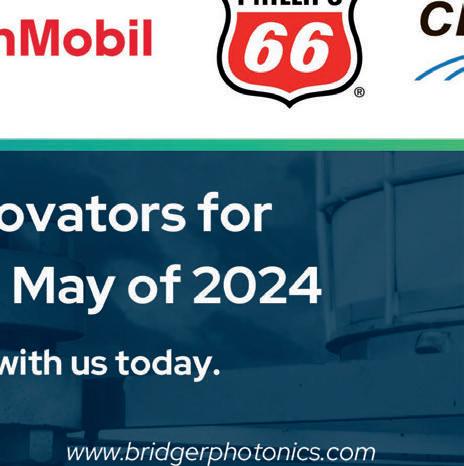

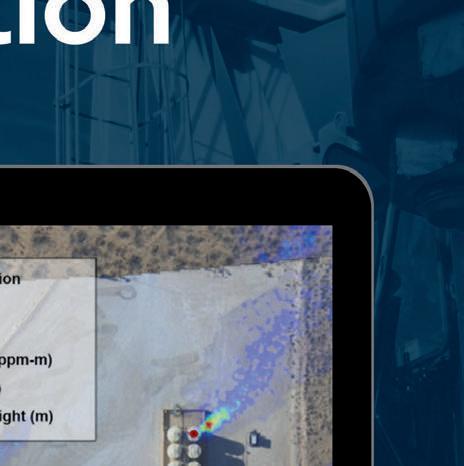
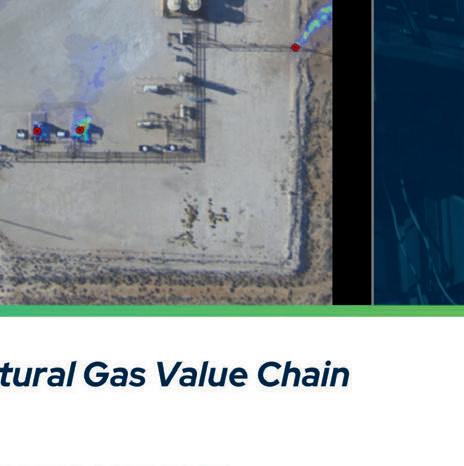
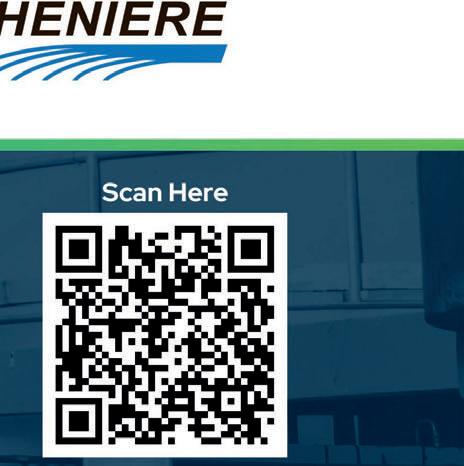
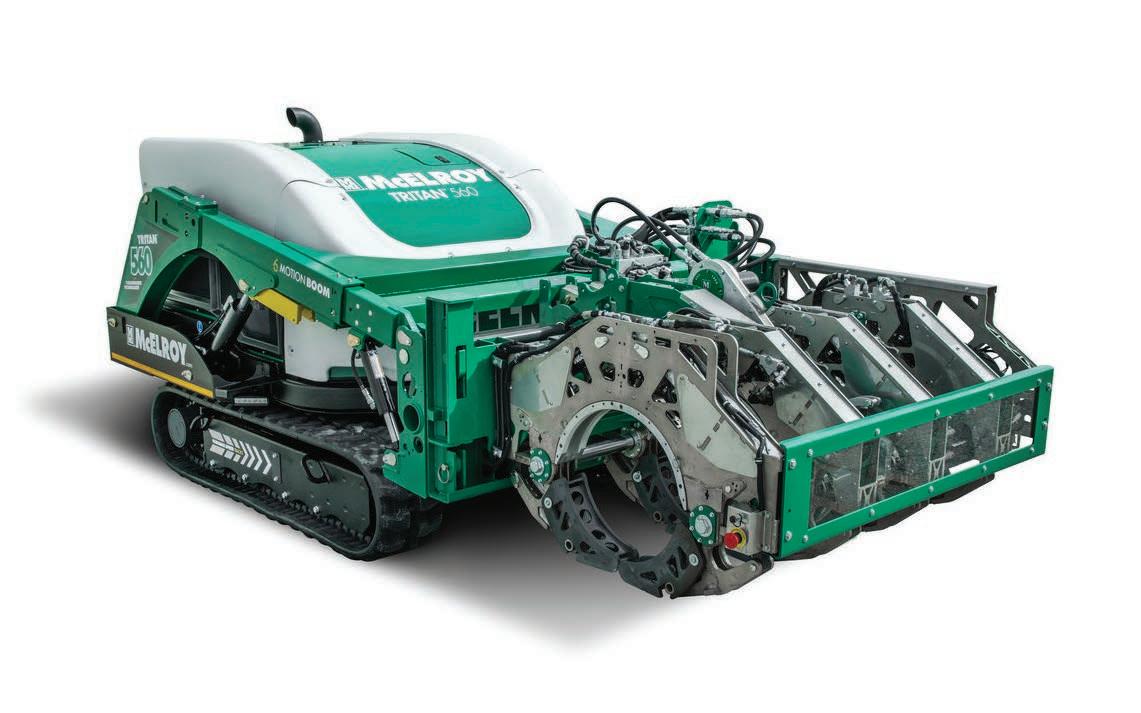
The Tritan 560 is the newest member of McElroy’s pipe fusion lineup and is set to arrive in Australia soon.
The Tritan 560 combines features of three of McElroy’s most innovative machines; the rugged portability and technology of the TracStar iSeries, the bottom-loading capabilities of the Talon 2000, and the Acrobat QuikFit carriage’s ability to meet the pipe where it lays on the job.
With those innovations in mind, McElroy designed a machine that rethinks the fusion jobsite with an eye for e ciency and worker safety.
e Tritan’s bottom-loading carriage sets it apart from the other equipment in McElroy’s fusion lineup, along with its full 360-degree rotation and a boom that can raise, extend, and curl the carriage to approach and load pipe.
With the Tritan, there’s no need to top-load pipe into the machine, and the machine operator is able to safely and easily position the Tritan using the DataLogger® tablet, which allows them better visibility to ensure there’s nothing – and no one – in the way of the machine.
“Because the design of the Tritan allows so much freedom of movement, wireless controls were developed so the operator can move wherever is needed for the best visibility,” McElroy Product Innovation Manager Mike Pacheco said.
e Tritan o ers a removable carriage that can operate in a two one two or three and one con guration, in both a top-loading or bottom-
loading setup for maximum exibility in the eld.
In con ned spaces or in-ditch applications, the carriage can be loaded directly onto the pipe from above, minimising the amount of excavation required under the pipe.
To take the e ciency improvements a step further, the Tritan 560 aids in pipe positioning, allowing for more exibility and increased performance and productivity.
With the same rugged, dual rubber tracks found on McElroy TracStar machines, the Tritan o ers all-terrain mobility to easily travel across a variety of terrains and can be driven directly to and from the pipe itself.
By building o the legacy and design of multiple McElroy units, the Tritan minimises the amount of time spent between fusions while also letting the machine work in tight areas.
In addition to its other revolutionary functions and features, the Tritan includes a hydraulically powered generator to supply voltage to its heater.
Rather than energising and de-energising the heater to control its temperature, this new approach varies the motor’s speed to raise and lower voltage. For operators and contractors, that means less fuel consumption and an overall reduction in engine noise.
Many operators are familiar with using the DataLogger 7 as a wireless control for the TracStar iSeries. e Tritan 560’s design takes that functionality a step further, with the DataLogger
7 poised to fully, wirelessly operate the vehicle as its primary interface.
e Tritan’s controls work seamlessly through the DataLogger, including its basic function controls, the bottom-loading carriage, rotation, and boom.
e DataLogger is a staple of the fusion industry, allowing contractors and operators to capture, store, and share fusion data.
In the years since its release, the DataLogger has proven itself an invaluable tool for operators, managers, and inspectors due to its ability to document all aspects of the fusion process from start to nish, including metrics like GPS and operator identi cation for each joint fused, anywhere in the world.
DataLogger integration also allows users to take full advantage of McElroy’s Vault, a powerful cloud-based tool to collect, store, analyse, and share joint reports and project information.
Its easy-to-use interface also allows for the recording of each fusion’s GPS location, machine, and operator information, along with joint data.
“As contractors begin to receive and use their Tritan 560 machines, we’re excited to see how they apply the Tritan’s functionality to real-world applications,” McElroy President and CEO Chip McElroy said.
“ e Tritan 560 builds o the success of our existing lineup, and we can’t wait to see this latest machine add to that legacy.”


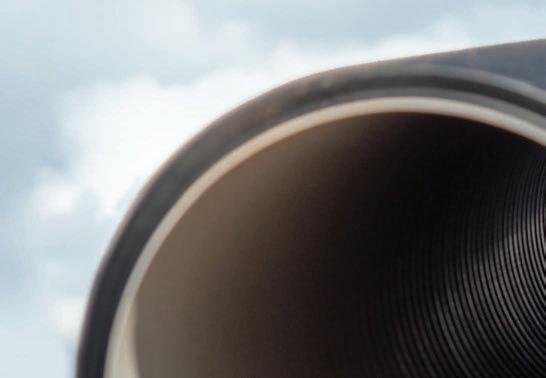









Gippsland Water has completed two major projects to provide local communities with water security. The Australian Pipeliner takes a look at the two projects helping increase water supply and improve sewer system capacity.
Securing water and ensuring sewer systems are optimal for the future is vital, and no one knows this quite like Gippsland Water.
e utility’s new pipeline is delivering more water to Drouin via the Moe-Warragul interconnect, creating a second source for the quickly expanding Victorian town.
Gippsland Water Senior Project Delivery Lead David Peake said this project had been crucial for the communities in the region.
“ e Warragul western ring main is a large diameter transfer main that loops through a largely undeveloped area to the west and south of Warragul. e project has allowed for future development between the Warragul and Drouin townships,” he said.
“Hydraulic modelling has also shown that the addition of the Warragul western ring main balances the pressure and ow characteristics of the Warragul water supply system, which signi cantly decreases the reliance on pre-existing large diameter assets in the township.”
According to Peake, Warragul, Drouin, and surrounding towns have developed signi cantly in the last decade and the western ring main is part of Gippsland Water’s work to proactively manage the region's growing water and wastewater needs.
e main was constructed using horizontal



drilling (HDD) methods, which was selected to minimise the impact of the project on native ora and fauna, including the Warragul Burrowing Cray sh and Giant Gippsland

“ e main extends for about 4.3km and consists of a 0.7km of DN450 PVC-M PN16 pipe section which was constructed via open trenching. 3.1km of DN560 PE100 PN 16 pipe was installed using trenchless (HDD) methods and 0.5km of DN560 PE100 PN16 was also constructed via open trenching,” Peake said.
“ e project was largely bored rather than open trenched to minimise the impacts to the natural environment.”
e new pipeline travels in a north-westerly direction through road reserves from Butlers Track to the railway crossing on Lardners Track.
It has also provided an alternative supply to the town of Warragul that can be used during maintenance or emergency work, avoiding interruptions to customers’ water supply.
According to Gippsland Water, Warragul and Drouin are two of the fastest growing towns in the region, and understand that building water and wastewater infrastructure is vital to keep ahead of the growth – and the Warragul western
directional Earthworm habitats.ring main project is an essential part of this work.
e pipeline will assist development in the south-west growth corridor of Warragul. It will also increase the volume and security of water supplies for Drouin.
e water main will be constructed around existing urban areas to provide an additional main to supply water to Drouin, with further extensions of the pipeline planned in the future, in line with local urban development.
roughout the process, Gippsland Water has actively worked to protect environmental and cultural heritage values, with environmental assessments completed for the Giant Gippsland Earthworm, Warragul Burrowing Cray sh and Strzelecki Gums.
e utility is committed to protecting environmental and cultural heritage values as the project continues, as well as making sure the works cause minimal disruption to the local species by using underground boring and keeping the route along previously disturbed areas of road.
Gippsland Water is working with Traditional Owners to protect cultural heritage and any artefacts found.
Community consultation and engagement was also inherent to the project, as Gippsland Water engaged with residents and stakeholders while planning for this work, including consulting
As local communities’ demographics are booming, these projects were needed for a continued water security.



residents along the pipe route.
Gippsland Water has also started works to increase the Warragul’s north-east region’s sewer system capacity starting this year.
e project, for which a $7 million contract was awarded late last year, involves upgrading a 1.5km section of existing sewer main by installing a new larger pipeline.
Gippsland Water Managing Director Sarah Cumming said the new sewer main was an important upgrade and would help prepare for Warragul’s future.
“We always look ahead and plan for the future to determine what services our customers will need and when,” she said.
e new pipeline will transfer all wastewater from homes and businesses in Warragul’s northeast future boundary to the town’s wastewater treatment plant.
Construction will begin within the boundaries of the Warragul wastewater treatment plant before progressing in a northerly direction towards Stoddarts Road.
“It’s essential for our network to be able to withstand pressures like population growth, rainfall variability and climate change,” Cumming said.


“ e existing sewer main was built in 1971, when there were fewer homes and businesses in the area, but it is now nearing capacity.
“Upgrades like this one also bene t the environment by reducing the risk of spills and main failures.”
Construction will begin in the coming weeks, with tra c management in place on roads at various times during construction.
e project is on track to be completed in mid 2025.
Rädlinger primus line GmbH sat down with The Australian Pipeliner to discuss the environmental bene ts of trenchless technology.
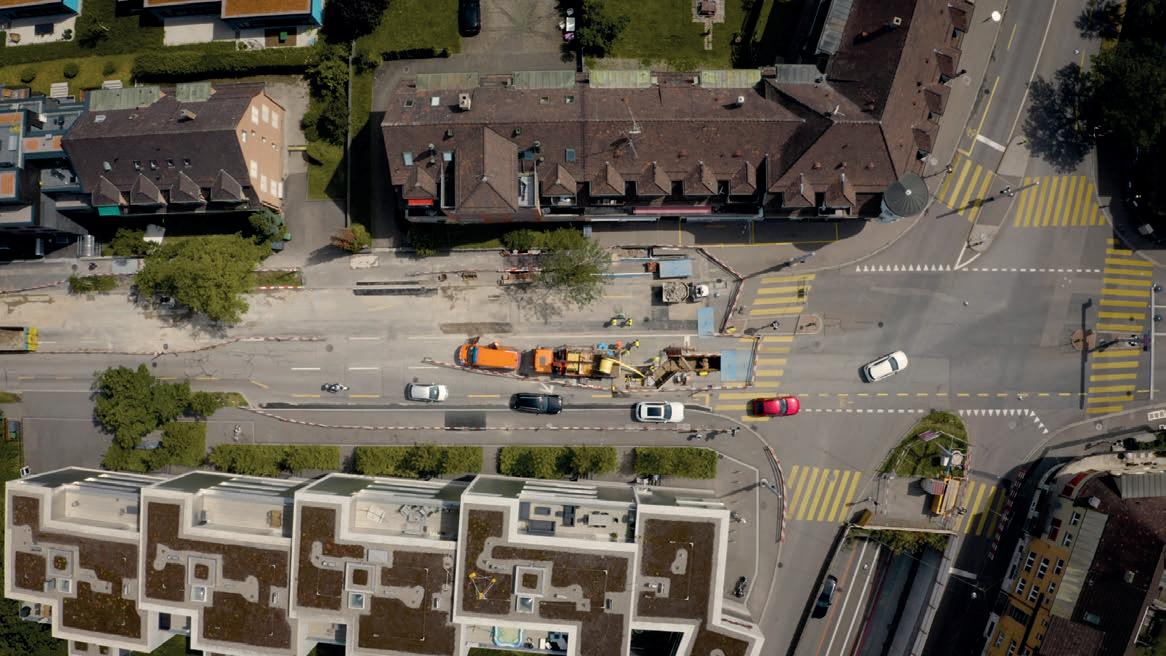
Climate change and reducing emissions appear to be the buzz words not only in ltrating the pipeline industry currently, but the minds of politicians, business leaders and the public, according to Rädlinger primus line GmbH.
Global e orts to reduce carbon emissions are driving initiatives such as switching to renewable energy sources or implementing energy-e cient and sustainable technologies in transport, buildings, and industry.
gas or mining companies, often implement comprehensive strategies to reduce their carbon footprint by setting speci c dates or timelines, often in line with global climate targets or internal sustainability goals. For example, companies
committing to achieving carbon neutrality by a speci c year, such as 2050.
Germany, for example, aims to be greenhouse gas (GHG) neutral by 2045. Rädlinger primus line GmbH, German manufacturer of the Primus Line system for trenchless rehabilitation of pressure pipes and above-ground uid transport, is already making a contribution in this sense –through the product itself, which is installed worldwide, and through activities initiated at the company’s headquarters.
Trenchless technologies require only small construction pits allowing tra c to continue owing in an urban environment.
Trenchless pressure pipe rehabilitation technologies are generally considered to be a more sustainable alternative to open trench solutions.
ese trenchless technologies score highly in terms of greenhouse gas, noise, and particulate emissions due to signi cantly less or no tra c delays and diversions and fewer construction machines and faster construction.
ey also reduce disposal of excavated material and minimise trucking of construction materials to the site and reduce the need for construction materials such as asphalt, concrete, stone or back ll.
more transparent for its customers and to lead the

Compared to open trenching, trenchless technologies such as Primus Line Rehab are more sustainable due to lower construction, social and environmental costs.
e use of trenchless technology can lead to signi cant greenhouse gas savings of up to 90 per cent, as reported in Information 31 “CO2 Initiative” by the German Society for Trenchless Technology (GSTT).
Greenhouse gas inventory and measures already implemented
Apart from the advantages inherent in the product, Rädlinger primus line GmbH has regularly determined its carbon footprint –formally known as the greenhouse gas inventory – by independent service providers.
e GHG inventory for 2022 was 4908 tCO2e which is equivalent to the output of
around 1385 European Union (EU) households (which is less than 0.001 per cent of all households in the EU), or a cruise of less than two weeks.
One third of the company’s eet is already electric. Electric and diesel forklifts are being replaced by more e cient electric ones.
Renewable energy also plays an important role. New photovoltaic systems on production facilities and warehouses supply the buildings with electricity. Own consumption averages around 30 per cent, with the remainder fed into the public grid.
In addition, Primus Line’s logistics centre at the headquarters uses heat recovery and heat pump technology to generate its own energy. Waste sorting and recycling is a matter of source.
neutrality by 2030
Rädlinger primus line GmbH aims to be location-neutral already by 2030. To this end, the company operates an active energy management system in accordance with ISO 50001.
e main objectives are to continuously save energy and increase energy self-su ciency in


order to become less dependent on fossil fuels. is already resulted in a speci c energy saving of 20.4 per cent in relation to turnover from 2021 to 2022.
In addition, Rädlinger primus line GmbH intends to identify and qualify suppliers with a lower footprint – if possible. Currently, only a few suppliers have prepared their GHG inventory.





Bottom line
e reduced carbon footprint of products and manufacturers is also playing an increasingly important role in tendering processes.
e family-owned company has started the process of becoming carbon neutral and will keep an eye on it by continuing to preserve an environment worth living in for future generations.
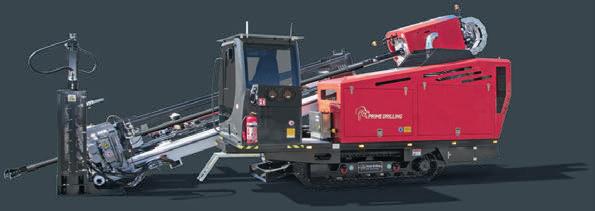



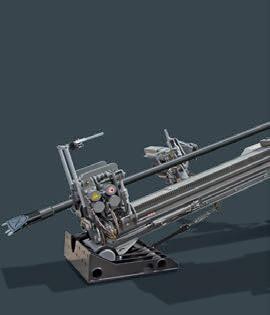



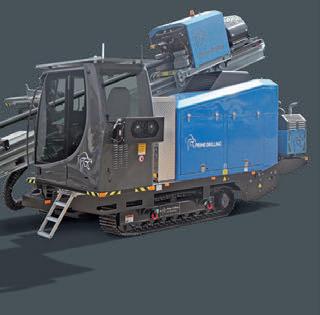
Construction works can have signi cant environmental impacts. Herrenknecht AG breaks down the bene ts of trenchless solutions in pipeline landfall installations.

When it comes to environmental impacts, trenchless solutions are indispensable to maximise protection and achieve public acceptance in coastal infrastructure projects.
In addition to the well-known horizontal directional drilling (HDD), slurry microtunnelling methods such as pipe jacking and Direct Pipe are the most widespread techniques to construct casing tunnels or install pipelines, both with jobsite installation onshore and subsequent subsea recovery of the microtunnelling machine.
Several industries bene t from the further development of these slurry microtunnelling methods and the wide range of opportunities they provide.
Important milestones have been achieved on the coast of Mexico, where a 2246m pipe jacking sea outfall (ID 2600mm) and a 56-inch Direct Pipe have been executed for the TexasTuxpan pipeline.
Another application of trenchless shore approaches are seawater intakes and outlets for desalination. Due to water scarcity, desalination plants are being built all over the globe.
A launch shaft is excavated at the landside where the jacking frame is installed. Its hydraulic jacks are used to push the jacking pipes through the ground out to a prede ned target point on the seabed. At the same time, a remote-controlled microtunnelling machine excavates the soil at the tunnel face.
is means no personnel have to work in the tunnel during construction. e position of the remote-controlled machine is monitored by a

guidance system. With smart lubrication of the pipe string, by a volume-controlled bentonite lubrication system, and the use of interjacking stations, friction forces along the tunnel and respective jacking loads of the jacking frame in the launch shaft can be managed.
Tunnelling machines used for sea outfalls are additionally equipped with a subsea recovery module, consisting of a steel can with bulkhead to close the machine, and hydraulic cylinders to separate the machine from the pipe string.
e required hydraulic lines for these cylinders are connected by divers to the outer skin of the recovery module.
In most cases the tunnelling machine has to be recovered and lifted up to the surface via a crane on a barge or on a jack-up platform. It is also possible to bring the machine to the surface by otation through the use of air bags, xed by divers to the lifting eyes of the machine.
One example of this method can be seen through the Sur de Texas-Tuxpan gas pipeline, which connects the coasts of Texas and Mexico across the Gulf of Mexico.
A total of three landfalls were realised for the installation of the pipeline: two with the Direct Pipe method and one with pipe jacking.
With a drive length of 2246m, the pipe jacked casing tunnel (ID2600, OD3200) in Altamira, Mexico, executed by Eurohinca, set a new benchmark in terms of sea outfall tunnel construction and long-distance pipe jacking.
e Direct Pipe method for trenchless installation of prefabricated steel pipelines combines slurry microtunnelling technology with the so-called Pipe ruster, a thrust unit
developed for HDD originally.
Direct Pipe incorporates the advantages of slurry microtunnelling to enable trenchless pipeline installation in di cult ground conditions, while reducing risks typically associated with HDD.
Due to its high accuracy and wide application range regarding geological conditions, Direct Pipe is a very competitive method to both HDD and open-cut installations when shore approaches of pipelines are being considered.
Especially in highly permeable or heterogeneous soils, this installation method is considered the safest and most reliable technology, as it installs the pipeline in a single step, with permanent borehole support. Like microtunnelling, the cutting head is equipped with tools consistent to the geological requirements.
is ensures high performance in the respective ground conditions and makes Direct Pipe easily adaptable to a vast variety of ground conditions. is can be seen through a water treatment outfall in New Zealand.
Just under four months after launch for the rst, 1930m long drive, the site crew in New Zealand's Whangaparaoa could report the successful breakthrough of the DPMTBM "Blanche".
With the second drive, over a length of 2021m, the DP-MTBM tunneled its way through the New Zealand subsoil out to the sea, setting a new distance world record with Direct Pipe technology at the time.
In the realm of trenchless pipeline landfalls, HDD is widely recognised as a proven method,


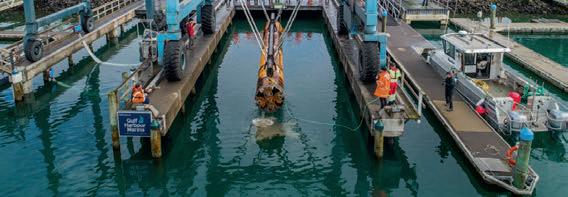
o ering signi cant economic advantages. However, in certain cases, subsurface conditions may not permit its application.
With increasing environmental awareness and a rising number of HDD projects for the installation of pipelines and underground cables and landfalls, smaller installation diameters are required.
is increases the potential for smaller rig sizes, reducing emissions and saving resources.
All-electric HDD rigs, such as HK300TE and HK45CKE, are a signi cant step towards

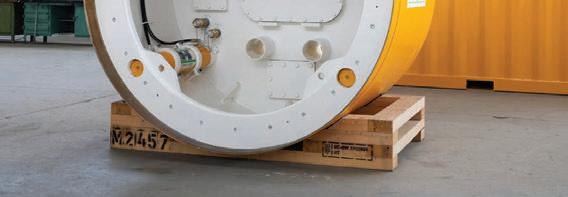
the energy transition, making green energies usable in the drilling industry.
A directly electrically driven rig enables the use of green electricity and assures higher e ciency without the losses associated with the hydraulic system.
Herrenknecht´s rst all-electric rig
HK300TE has already completed several HDD crossings in various ground conditions up to date.
In Belgium, Germany and the Netherlands, the HK300TE all-electric trailer rig was used to
install water and sewage lines, cable protective pipes and gas pipeline sections, with up to more than 1300m of single crossing length.
Expanding the all-electric rig eet, in addition to the 300-tonne all-electric HK300TE rig, the next focus were the medium-sized rigs, such as the 45-ton range and with the new all-electric HK45CKE.
e driving force to reach into this size range, which is currently the smallest rig made by Herrenknecht, was the development of the power grid in central Europe.

The construction industry is fast-moving and constantly developing, and companies that actively evolve and grow to keep pace with the latest technology clearly showcase their industry expertise and are
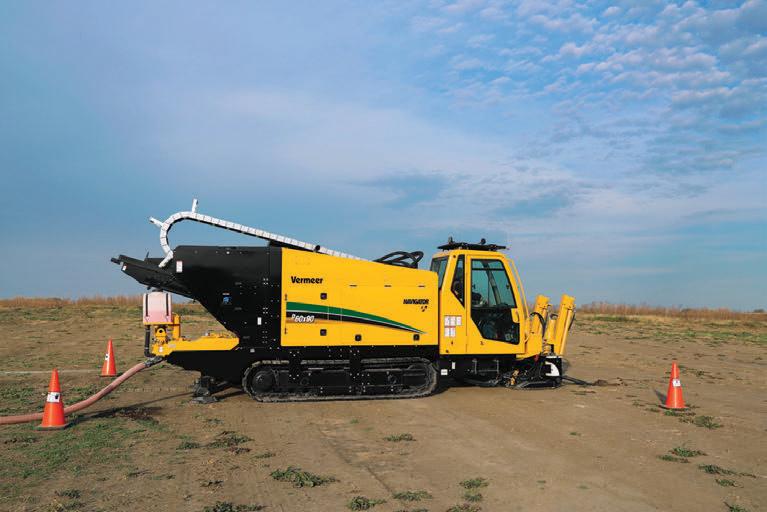
technological innovations have seen the technology – a game changer in major pipeline and underground utility installation.
Having always prided itself on being ahead of the game, Vermeer saw the potential of game changing trenchless technology and rose to the occasion.
Ahead of the curve
In the 1970s, Gary Vermeer had a vision: If Vermeer could develop a machine that could dig in a similar manner to a mole tunnelling underneath the surface – without opening a trench – it would blow open the market and make Vermeer an industry pioneer.
Over the following decades this vision became a reality, and the industry realised the impact this would have in underground construction.
Vermeer HDD machines – the rst of many Trenchless machines started appearing on the Australian market in the 1990s, with demand for this technology swiftly rising. From Vermeer’s perspective, it was the perfect time to start designing its own trenchless machinery, putting its own unique spin on the cuttingedge technology.
e rst horizontal directional drilling (HDD) machine that Vermeer brought to the market was the Navigator® 9 (later known as
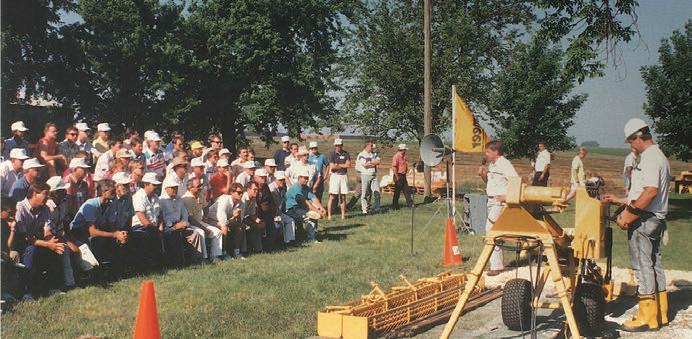
the D7 model) in 1991.
e Navigator was a more basic model than the HDD machinery on o er today and required a large amount of labour to set up and commence drilling. Also, at this point in time, everything on the machines involved a manual process.
A characteristic of Vermeer that sets it apart from its competitors is its commitment to listening to and working with its customers.
e team spent a lot of time staging demonstrations of its HDD machinery for customers, gathering their feedback and introducing them to the technology.
e year 1995 saw the second generation of self-contained HDD drills introduced to the Australian market – the de ning moment for Vermeer, allowing it to put its mark on this upand-coming industry.
Additionally, the rollout of Foxtel and cable television meant an uptick in trenchless technology and Vermeer’s HDDs were often the machine of choice.

e late 1990s and early 2000s saw the introduction of Vermeer’s more compact HDDs, like the D7x11 and D16x20, which o ered more variety and versatility for those working with a eet of HDDs, particularly on larger projects.
As HDD needs have shifted, Vermeer has evolved and updated its range to ensure it always o ers the best technology to customers.
Vermeer’s S3 range was introduced in 2015 and made rock drilling a lot simpler for operators, from the smaller D10x15 S3 HDD, weighing just over 3000kg, to the 17,000kg D60x90 S3 HDD, and more recently, the new D100x140 S3 weighing in at over 22,000kg.
As HDD requirements change, Vermeer is there every step of the way, constantly updating its range and continuing to prove itself as a highquality solution for trenchless needs – from telecommunications and electricity to gas, water and energy pipelines.















When McConnell Dowell needed a solution for the Narre Warren-Cranbourne Road upgrade, Vinidex provided a solution with StormPRO.

In Victoria, the Narre Warren-Cranbourne Road is a crucial thoroughfare that links the South Gippsland Highway to Cranbourne’s High Street.
is road however, was plagued by heavy tra c, leading to congestion and signi cant commuter delays. To address this issue, VicRoads launched the Big Build Project which included the construction of a straight-through road from South Gippsland Highway to improve tra c ow.
e project’s scope was extensive, featuring several upgrades aimed at enhancing community safety. ese included the addition of cycle ways, new safety barriers, and major improvements at the intersection of Narre Warren-Cranbourne Road and ompsons Road.
Faced with the need for a dependable stormwater solution that met the project’s design and sustainable criteria, contractor McConnell Dowell turned to StormPRO by Vinidex.
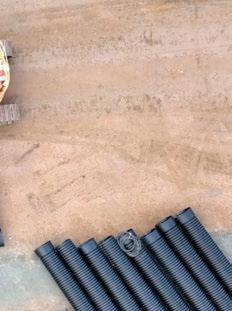
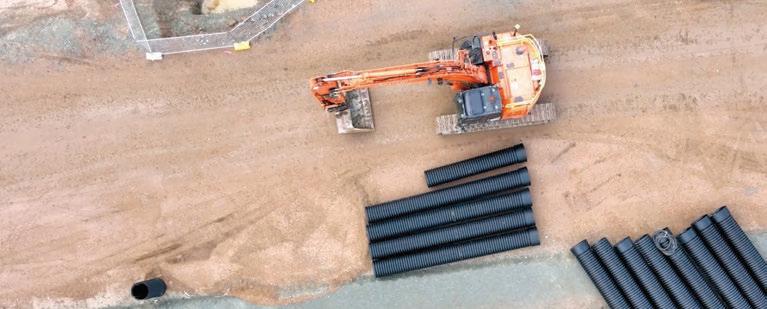
StormPRO was the favourable choice for McConnell Dowell as it is easier to use, quicker to install and cost e ective compared to reinforced concrete pipe, as McConnell Dowell Graduate Engineer Jarrod Woods explained.
“It’s a lot easier to use and quicker to install for the crews so it’s cost e ective and makes production a lot better,” Woods said.
StormPRO by Vinidex has been approved for use by numerous authority bodies, for drainage, stormwater, and culvert applications on large scale road and rail infrastructure projects. Its structured wall design ensures it is sti and holds its shape; has a high impact strength, and is exible, making it a robust yet adaptable option for various uses.
One of the key advantages of StormPRO was the reduced need for heavy lifting equipment, which translated into time savings during back lling and a shorter overall installation period. Moreover, StormPRO uses recycled materials in its manufacturing process which align
with the project’s sustainability goals. e pipes’ resistance to corrosion, abrasion, and chemicals made it suitable for the demanding conditions of the upgrade.
MRPV Project Manager Amir Dianati explained that StormPRO helped the project reach and meet its sustainability, environmental and recycling targets.
“We all are aware of the environment, sustainability, a circular economy to make sure that we can reuse and recycle as much as we can,” Dianati said.
Approximately 2.5km of StormPRO pipe was supplied as an alternative to concrete pipe.
StormPRO’s simple jointing process made installation easy for the project team, which was crucial in minimising road closures and utility relocation challenges. e longer and lighter lengths of pipe also helped toreduce health and safety risks and time constraints compared to heavier alternatives.
e successful implementation of StormPRO resulted in signi cant cost savings and a reduction in project timelines. Since it was introduced over 15 years ago, StormPRO has been used on countless successful installations, including several historic VicRoads projects, demonstrating its reliability and compliance with relevant Australian and VicRoads standards.
e Narre Warren-Cranbourne Road upgrade, is yet another prime example of how StormPRO is leading the way when it comes to Stormwater drainage solutions making it the rst choice on large-scale infrastructure projects.



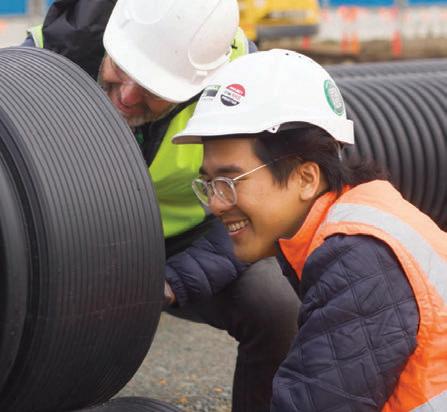




























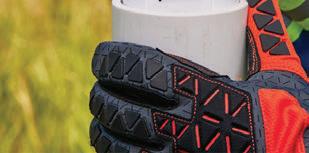






















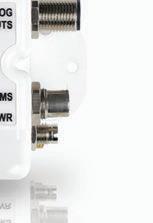










From one person and a dog to now a vital part of the South Australia’s energy supply system, SEA Gas has helped keep the lights on in the state since 2004.
The name SEA Gas ltered through the pipes of the industry following a catastrophic event at Santos’ Moomba gas plant facility on 1 January 2004.
It was from here the company’s rst leader Ashely Kellett laid strong foundations to build it to what it is today when the pipeline was commissioned earlier than expected, joining in the 2004 New Year’s Day celebrations.
SEA Gas was established in 2002 to develop, own and operate the 700km underground high-pressure natural gas pipeline transmission system from Port Campbell in
Victoria, connecting the Otway and Bass Basins, to Adelaide in South Australia.
A 50/50 partnership between APA Group and Rest, the pipeline system has been delivering gas to South Australia for 20 years and has no signs of slowing down.
In a recent VIP event to honour the milestone, Chief Executive O cer (CEO) Eric Bardy said it was with great pride and gratitude he stood before his guests to celebrate two decades of SEA Gas’ operations.
“I actually prefer to look to the future then dwell on the past, but it’s tting that we celebrate


the success of an organisation that has been helping keep the lights on in this state and more since 2004,” Bardy said.
With now 40 employees and a number of longstanding customers, SEA Gas sees them as the lifeblood of its existence. rough working with Origin, AGL, EA, Engie, SA Water, Teys, and Beston Foods, and the foundation shipper agreements ending in 2019 under Wendy Oldham’s leadership, the business has been able to look at innovative ways to meet its customers’ needs.

As a result, SEA Gas can now store enough gas on the pipeline to run Pelican Point for three to four days, continuing to demonstrate how the business has increased resilience and drive to meet the challenges of the energy transition.
Bardy acknowledged that while the business has changed in some facets, it will continue to change through the energy transition to both store and transport energy to use when the sun doesn’t shine, and the wind doesn’t blow.
“We're fully exposed to all of the elements of the energy transition that are going on the East Coast. Compared to when I started to now, I've seen the industry go from feeding baseload gas red power stations, to essentially power stations only sporadically needing gas for peak ow,” he said.
“We now pride ourselves on the fact that we can store gas for those days when it's required. Our role in the whole supply chain, for electricity, has changed dramatically. I've seen that rst-hand of running the pipeline as head of operations.
“ e transition for me to CEO is now I've gone from very much an inward-looking role to very much an outward looking role.”
Today, the SEA Gas pipeline consists of two compressors, one near Hamilton in Victoria and the other near Coomandook in South Australia, both helping hit the maximum allowable pipeline operating pressure of 15MPa.
Each compressor station is also equipped with a solar Centaur compressor plus gas turbine driver.
Striving to engage with the communities it operates in, SEA Gas maintains regular face-toface contact with nearly 1000 landholders who host its easements.
Additionally, its relationships with the South Australian and Victorian regulators has also helped the business’ commitment to prioritising public, process and personal safety while maintaining a reliable operation for its customers.
is was evident at the VIP evening when Minister for Energy Tom Koutsantonis, Shadow Minister for Energy and Net Zero Stephen Patterson, and Australian Pipeline and Gas Association CEO Steve Davies attended.
Looking at the future of SEA Gas’ goals, Bardy

(L-R)
for
and
said the focus is helping facilitate energy security for both South Australia and Victoria.
“ e southern states are moving towards being short of gas in a few years’ time and we are part of the answer,” he said.
“ is will be achieved by either bringing gas down from the north with a connection to the
For more information, visit seagas.com.au

Moomba pipeline, or by bringing gas in from an LNG import terminal.”
“We're happy with either of those, or both of those scenarios, and will continue working towards one or both of them over the next year or so as I believe we can help keep the lights on for decades to come.”
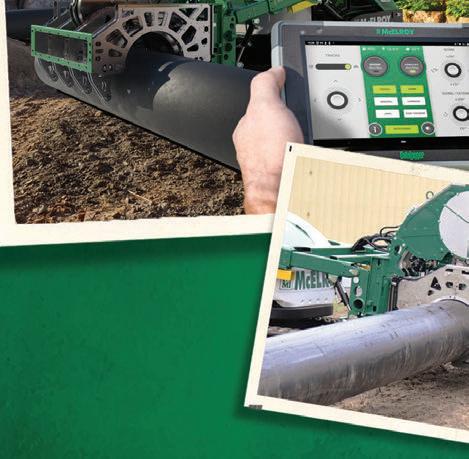

Mcelroy has a Long


of rede ning pipe fusion. Throughout the years, we’ve streamlined jobsite eciency and safety with equipment like the PolyHorse® and TracStar®. And we’ve done it again with our latest revolution, the Tritan™ 560. With the Tritan, one operator can position the machine, load the carriage, and fuse pipe without other equipment – saving time and money.




Learn More about The TRITAN and see the





‛We make it happenʼ is Austrack’s motto, and rightly so. The company is passionate about providing the pipeline industry with quality equipment paired with an unparalleled customer service.
Good customer service can mean many things, such as quality, trust, fairness, price, speed, e ciency, knowledge, responsiveness.
For Austrack Business Development Manager Mike O’Reilly, it involves all these attributes and sometimes a whole lot more.
“If it means anything at all it surely means delighting and surprising the customer,” he said.
“It’s all about going beyond reasonable customer expectations and delivering a result that is beyond what was expected, and understanding what the customer wants is generally the key and is always the starting point.”
According to O’Reilly. sometimes it is even about helping the customer understand exactly what it is that they need, because sometimes they don’t quite know.
“Austrack Equipment prides itself on its customer service and it is not alone,” he said.
e facility in which Austrack operates is a space where heavy machinery is hired out, often to meet impossibly tight deadlines, mostly delivered to remote, sometimes challenging locations.
It is a space where availability, reliability and performance intersect.
“Getting it right all the time is almost impossible,” O’Reilly said.
“But getting it right will always be the Austrack ambition.”
Perhaps the reasons for that, according to him, is because the team at Austrack listens to its customers, and they bring a huge amount of
knowledge and experience of the industry in which it operates.
“ at is a formidable combination of capabilities to ensure satisfactory customer outcomes,” he said.
A relatively new customer who had visited the Austrack yard in Brisbane to arrange delivery of a couple of SafeVac Vacuum Lifters for a water pipeline job in North Queensland shared his frustration with Austrack Principal Michael Benson.
He had not been able to source a sand hopper with some very speci c performance requirements and the unit he was after is not readily available.
Benson’s answer was short and simple: “Leave it with me, I’ll see what I can do.” is equipment is essentially one-o , purposebuilt, customised and nding one requires

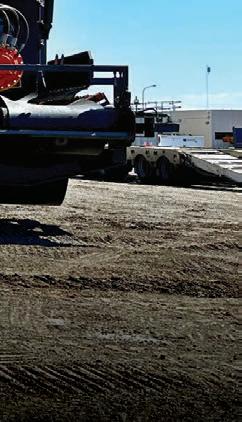
someone with extensive machinery knowledge and a signi cant industry contact base to locate the exact machine needed to do the job.
Benson succeeded in nding not one, but two specimens of the elusive sand hopper, however getting the equipment ready for its next project was another challenge for Austrack.
“Even after it has been sourced it will almost certainly involve a signi cant re t and customisation to get it ready for its next role. So, nding one is only the start of the solution for the customer,” O’Reilly said.
“But Austrack has that requirement covered as well.”
Under the expert supervision of Operations Manager Dylan Gamble, if the sand hopper can be found, it can be reinstated to pristine condition.
After an extensive re t at the Austrack yard

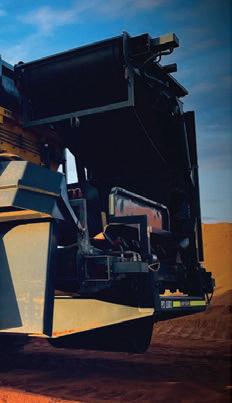
scoped and overseen by Gamble, the much sought after sand hopper was ready to add grunt, capacity, and cost savings to ensure the Austrack customer hit its project goals.
Its new home for the foreseeable future is on the Haughton Pipeline Project for the Townsville City Council which involves the installation of 1800DN Rubber ring glass reinforced plastic pipe.
“ is specialised unit is already kicking goals,” O’Reilly said.
“Moving at a steady pace this behemoth with a hopper capacity of 60 tonnes and a discharge conveyor that dispenses its precious bedding sand with unerring precision, exactly where it’s required for back lling the trench.”
According to him, the operation is smooth and e cient and the expensive sand wastage that is usually associated with conventional back ll is eliminated.
e savings on sand is only half the story as back lling from the hopper also reduces both machine and manpower requirements.
“Saving money and time in any project is a deadly result,” O’Reilly said.

“ e story of the sand hoppers is just one of the many happy endings engineered by Austrack for its customers by moving beyond the usual and providing the kind of customer service experience that can be taken to the bank.”
O’Reilly said no matter what the requirement is whether it is for excavators, padders, loaders, dozers, telehandlers, crawler carriers, tractors, backhoes, dumpers, moxys, or a mesmerising array of special attachments, Austrack can weave the same kind of magic as it did for the customer with the sand hoppers.
“Everything begins and ends with our customers,” Benson said.
“ e power and essence of it is that everyone in our business has a clear understanding that the only reason for our existence is the customers who choose to deal with us.”
For Benson, there’s no better purpose than serving Austrack customers with the best equipment, wherever and whenever.
“ e satisfaction we deliver to our customers essentially is what drives our growth and guarantees our success, and we never take that for granted.”



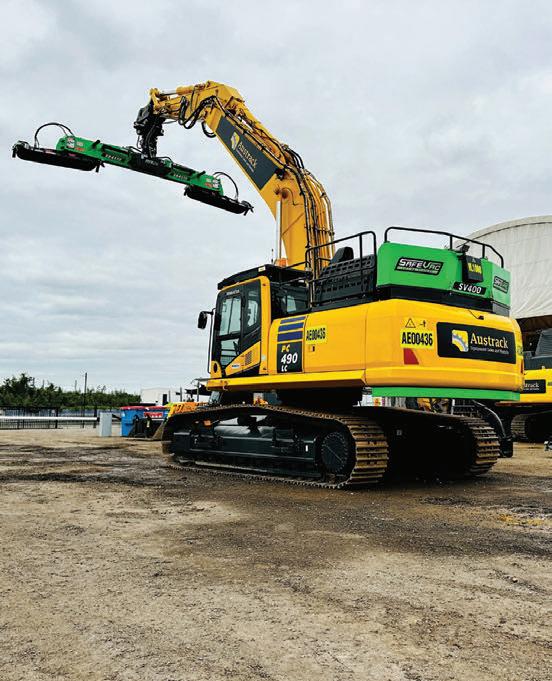




















ROSEN is known for its industry-leading inspection capabilities, as well as for its new and revolutionary approach when it comes to direct assessment.
Pipeline operators have a regulatory responsibility to demonstrate that their pipelines are safe for operation, but they also have to balance organisational responsibilities to maximise the value of their assets, minimise risks, and control costs.
Corrosion and other time-dependent anomalies are some of the major threats faced by operators, costing millions annually in identi cation, mitigation, and repair. e situation is often even more complicated for “unpiggable” pipelines, which pose their own unique challenges.
ROSEN is known for its industry-leading inspection capabilities. Where in-line inspection (ILI) is not possible or impractical, knowledgebased models reliant on data and assumptions for multiple variables are used.
Direct assessment (DA) is recognised as one such integrity assessment approach in Australian Standards (AS) 2885.3:2022; it involves combining the variables that are believed to
contribute speci cally to a given threat through a process of data alignment, engineering assessments and targeted in- eld activities.
DA can often require multiple iterations of costly excavations to obtain the data and clarity required to perform a robust assessment.
To address the concerns and challenges of the industry, ROSEN has developed its own approach to DA, the non-intrusive pipeline assessment (NIPA).
e NIPA methodology consists of integrating and overlaying pipeline datasets, such as construction and operational records, in conjunction with data obtained from large stando magnetometry (LSM) surveys to gain a holistic picture of the pipeline integrity condition.
is process involves an assessment of pipeline condition along with a review of data collected to support other critical elements of an integrity management plan, such as cathodic protection performance, internal corrosion control, and the

potential for pipe deformation due to ground movement or external interference.
All that is achieved without suspending or upsetting the operation of the pipeline.
ROSEN recently signed a strategic partnership with Speir Hunter, a market leader in LSM technology, to develop and improve the stress concentration tomography (SCT) tool.
e basic principle of SCT relies on the fact that whenever there is wall thickness loss or disruption in the pipe wall, there will be an increase in stress.
SCT can identify these abnormalities in the magnetic eld of a pipeline and apply an engineering evaluation to infer a stress value at these points in the pipeline.
As any mechanical or metallurgical anomaly will lead to localised stress zones in the pipeline wall, SCT will be able to support the detection of multiple anomaly types that can a ect buried pipelines (including: dents, bending strains, gouging and corrosion).
It is clear how this can dramatically improve the traditional DA process currently practiced across the industry and extend the DA process beyond its current focus on corrosion identi cation and management.
When SCT is combined with other complementary survey techniques, such as close interval protection survey (CIPS) and direct current voltage gradient (DCVG) assessment, it provides a more holistic picture of the pipeline condition without the need for intrusive inspections while minimising false positives –which reduces unnecessary excavations.
Using the ROSEN developed NIPA methodology, operators will bene t from the combination of a novel approach to applying LSM technology with ROSEN’s broad pipeline integrity expertise to screen for critical integrity threats and prioritise locations down to centimetre-scale accuracy for eld veri cation.
e combination of multiple datasets and ROSEN’s proprietary alignment and prioritisation algorithms has been proven through eld experience to signi cantly improve
identi cation of problem areas along a pipeline and aid in optimising excavation locations for further investigation, all without upsetting pipeline operation.
is data can then be used to enhance ongoing monitoring programs or to carry out remediation measures.
Based on the science of stress-magnetisation and recently incorporated into the latest version of the International Organisation for Standardisation (ISO) 22974:2023, SCT is a proven screening technology that can either be deployed to supplement an existing in-line inspection (ILI) program or used in unpiggable pipeline infrastructure as part of an enhanced DA process to focus and optimise excavation

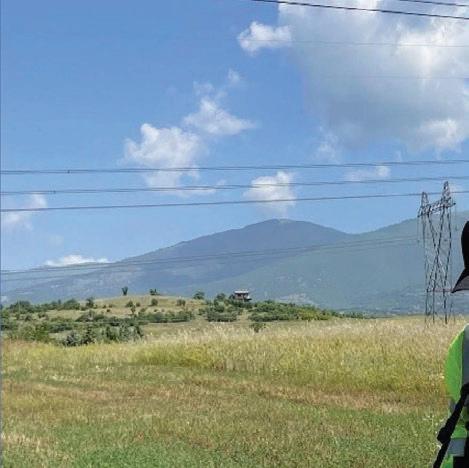

and inspection costs.
e NIPA approach has been developed and implemented by ROSEN since 2019; during this time, it has been constantly evolving and improving to meet the challenges posed by pipelines operating in di ering external environments around the world. e approach has been so successful in Europe that many clients now request repeat inspections to aid identi cation of changes in pipeline condition, counting on the high repeatability of the approach.
ROSEN is also now incorporating machine learning into the NIPA process using its V-ILI condition prediction models, which are based on the ROSEN Integrity Data Warehouse (IDW), a continuously expanding library of ILI data collected over many years by ROSEN that as of
January 2024 contained information from more than 26,000 pipelines. is o ers a truly unique proposition in the industry.
ROSEN’s V-ILI combines other relevant data, such as rainfall, soil type and coating, with information about corrosion trends across thousands of pipeline segments stored in the IDW. rough machine learning algorithms trained on this historical data, the incorporation of V-ILI into NIPA has the potential to substantially reduce uncertainty in the DA process.

is expands the data horizon by not only considering the local results of the pipeline in question, but also how every other pipeline identi ed in the IDW has behaved, which provides valuable insights for condition prediction.
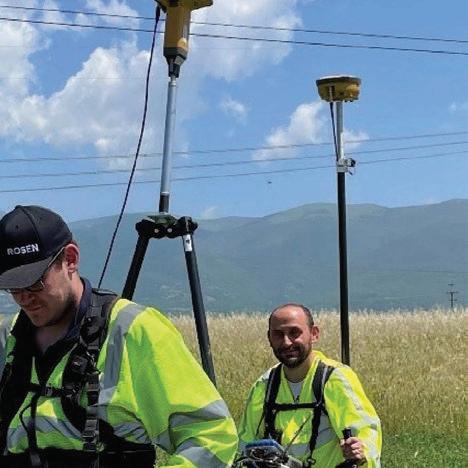



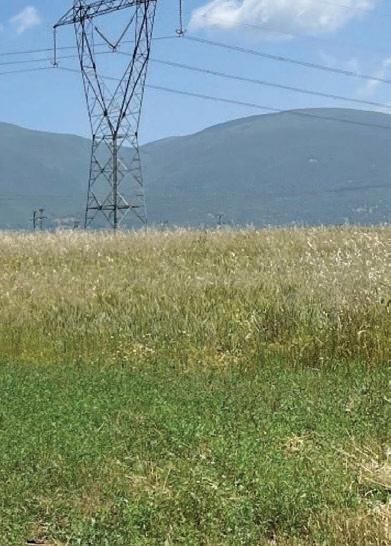


With the recent addition of a new vacuum truck to its eet, Abletech Underground is charting a path of steady growth and expansion within the pipeline industry.

serve as a vital conduit for transporting gas to domestic and international markets.
It is safe to say Abletech Underground’s success isn't solely attributed to capital investments, but also through investing in its workforce.
e company prioritises its sta through upskilling and training programs.

Acommitment to providing specialist industry solutions for utility protection and maintenance across the construction, mining, and civil industries, Abletech Underground is on the trajectory to become a leading supplier in the pipeline industry.
When looking at its presence, progression, and its recent strategic investment of $1 million, it reinforces that there is no slowing down.
Abletech Underground has allocated the purchase of $1 million in essential assets and infrastructure. is included acquiring an
Kelsee Stevens said this move not only bolstered Abletech Underground’s operational capabilities, but also positioned the company to cater for demand in the region.
“ e Surat basin is certainly an area of focus for our team, but it is also a gateway to further regions,” Stevens said.
“Our new depot in the basin has allowed to support projects in a vast wider region.”
Nestled in Queensland’s outback, the Surat Basin is known for its coal seam gas and conventional gas reserves.
e basin has attracted signi cant attention
By nurturing sta and equipping them with the latest industry knowledge and techniques, the Abletech Underground ensures a high level of competency across its workforce.
“By investing in our personnel to acquire advanced industry skills, it ensures that their contribution made onsite will assist in the progression and success of our clients’ projects,” Stevens said.
“It not only assists our clients, but ensures our sta have every opportunity to succeed within their role.”
According to Stevens, the company’s growth doesn’t stop here, but only the beginning.
“We are actively seeking new projects and new clients,” Stevens said.
“ e Abletech team is excited to focus on developing long term relationships, and a quality service personalised to each of our clients’ needs.”
With a supportive workforce and new equipment under its belt, Abletech Underground is making ground within the pipeline industry as a preferred supplier.
As the demand for pipeline projects continues




As
REHAB AND REPAIR
As remote monitoring technologies continue to advance, more and more operators are deploying remote monitoring units across their operations.
Written by the CCE Engineering Team.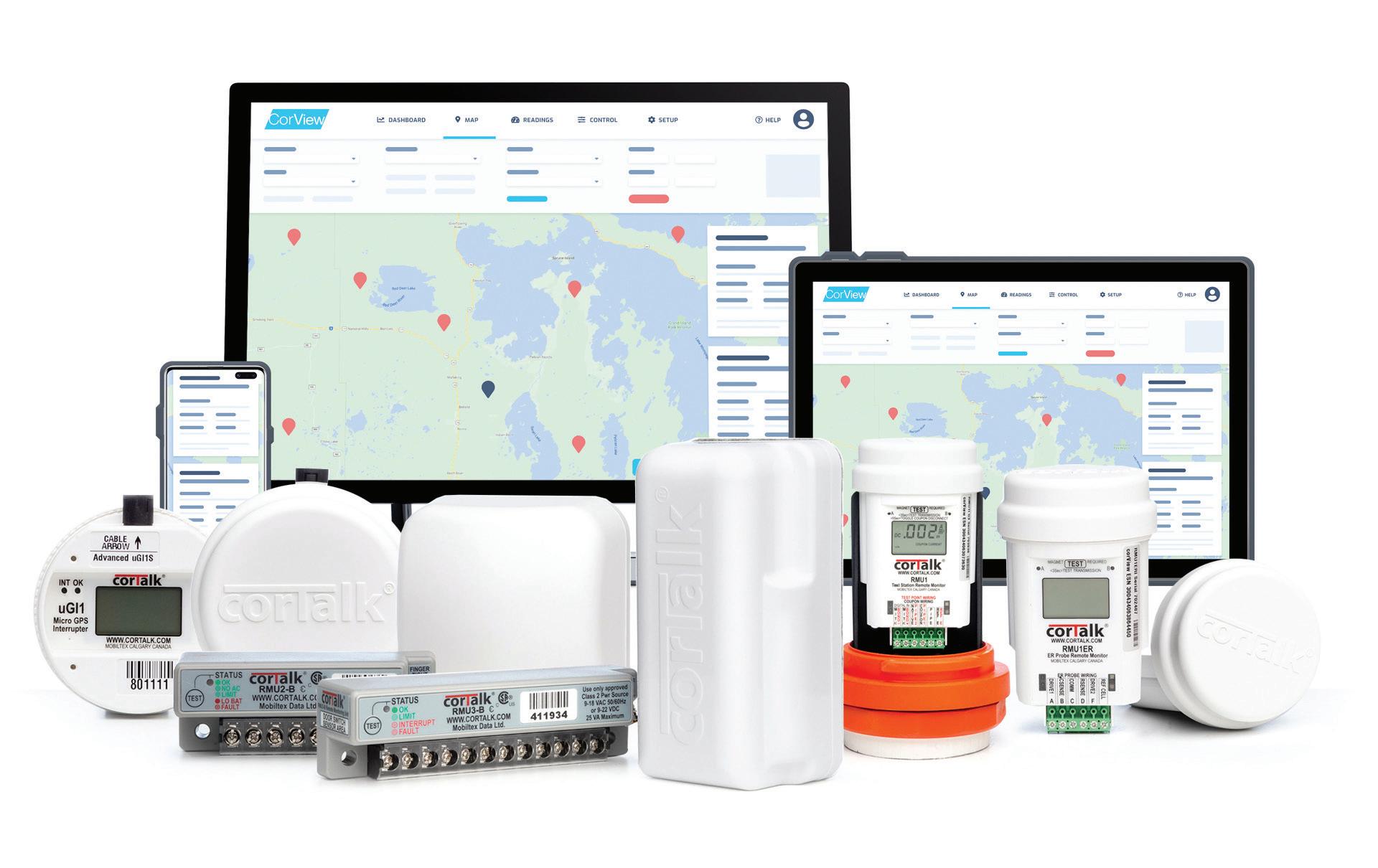
Remote monitoring technologies enable technicians to focus on more impactful tasks of troubleshooting and optimise cathodic protection (CP) systems while reducing emissions.
With advances in communications, this is economically possible, regardless of geographical locations.
Fit-for-purpose remote monitoring units (RMU) are serving as a catalyst for more strategic and challenging eld applications, with improved data capture monitoring the ongoing virtual real time integrity of the CP systems.
For years critical infrastructure operators and their supporting contractors have been aware of the need to e ectively recruit new employees as more and more skilled eld personnel approach retirement, while concurrently moving to upskill the existing workforce and begin leveraging new technologies to ll the resulting gap.
Recent employment studies con rm that nearly two-thirds of operators within a wide range of critical infrastructure sectors are approaching retirement age.
Operators managing the integrity and safety of critical infrastructure could nd themselves dangerously understa ed and scrambling for solutions, while still focusing on an improved carbon footprint.
Online tools exist which allows the automation of CP data collection thereby reducing the operating costs operating costs, and in most cases, enables full recovery of the capital cost of the RMU devices in less than two budget cycles.
Operations also predict in ationary price pressure will signi cantly increase the costs associated with employment, travel, accommodation, and equipment for CP technicians in the future, which contributes to an even more favorable return on investment (ROI) for strategic CP automation through RMU.
e ongoing cost of data monitoring and
analysis are nowadays relatively low, so once the devices have achieved their ROI, pipeline operators continue to bene t year after year from a signi cant reduction in asset management costs. is is also alongside a more complete CP monitoring data set, which can dramatically increase productivity, personnel safety, and a reduced carbon footprint.
With advances in communications capabilities worldwide, this is now possible virtually irrespective of geographical locations, further reducing the requirement for regular travel to remote locations while still enabling the monitoring of these remote systems.
RMU plays a crucial role in helping cathodic protection systems meet regulatory requirements by providing real-time monitoring, e cient data collection, and analysis capabilities.
RMUs facilitate compliance with regulatory standards:
• Continuous monitoring: RMU enables continuous monitoring of critical parameters, such as pipe-to-soil potential, current density, and corrosion rate, which are essential for assessing the e ectiveness of the cathodic protection system. is continuous monitoring ensures that any deviations from regulatory thresholds are promptly detected and addressed. RMU can be con gured to generate alerts and noti cations in case of abnormal conditions or system malfunctions. By promptly alerting operators to potential issues, RMU facilitates timely interventions to prevent corrosion-related failures and maintain regulatory compliance with a reduction in site time and unnecessary travel to remote locations.
• Data logging and reporting: RMU smart platforms collect and store data over time, allowing operators to generate comprehensive reports for regulatory agencies. ese reports demonstrate compliance with regulatory requirements and provide evidence of the e ectiveness of the cathodic protection system. RMU maintains a detailed audit trail of monitoring activities and system events, providing documentation for regulatory audits and inspections. is documentation demonstrates compliance with regulatory standards and helps address any inquiries or concerns raised by regulators.
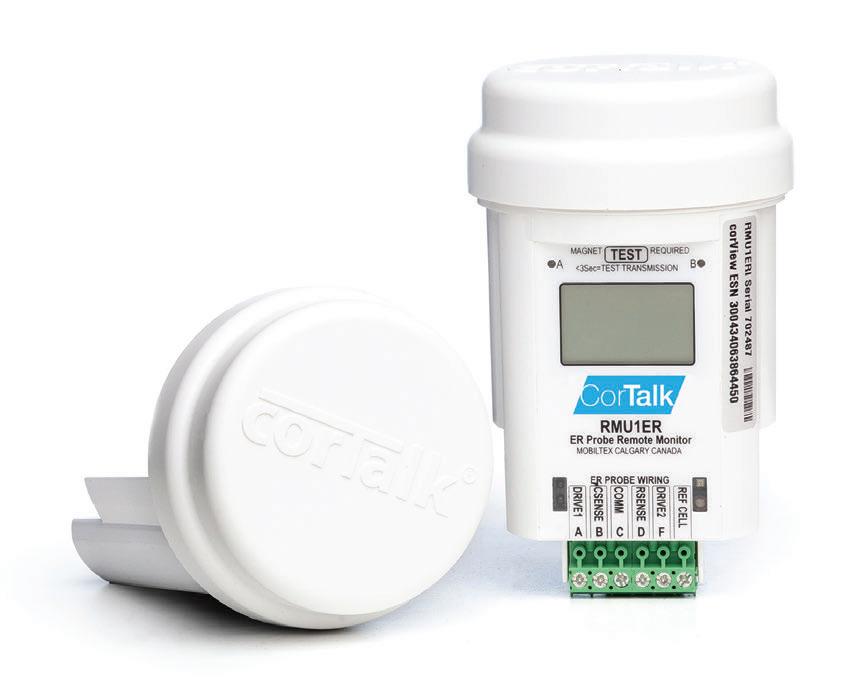
e digital transformation and carbon reduction remains top-of-mind for critical infrastructure leaders and for many, plans have been accelerated. Numerous organisations are investing in automation to drive e ciencies, followed by investment in arti cial intelligence (AI). ere is a clear shift in applying digital technologies from transactional to analytical work ows and taking a more proactive and preventative approach with the data.
And while many industries initially thought the digital transformation would result in further job losses, it has infact resulted in a shift in skills. Operations need data experts skilled at understanding data sources, analysing, extracting, and manipulating data to gain insights, and then working together with technical subject matter experts to understand the data and putting it to practical use in the eld.
e use of next-generation platform solutions with specialised, high-resolution RMU extends
far beyond just the collection of data. e ability of the associated platform to not only store readings but also leverage AI and machine learning to automate the analysis of historical data is crucial for generating valuable prediction models, identifying trends, and optimising CP systems as a whole. Such data-driven strategies can consider variables like environmental conditions and seasonal changes.
By applying predictive analytics to recti er output data from RMU, operators can now accurately anticipate the degradation of groundbeds. is foresight is instrumental towards e ective operating expenses or expenditure budget planning for signi cant system overhauls, but it also empowers operations to optimise strategic planning in order to maximize the value they can realise from expensive dig projects and improving emissions reductions.
Troubleshooting CP systems also bene t from RMU capabilities. Continuous monitoring of interference bonds plays a critical role in system integrity. e importance of RMU monitoring in preventing catastrophic failures due to external corrosion is well-known and understood. Strategically deployed RMU have also enabled
detection of ‘recti er-of-in uence’ for an electrically continuous system.
Next generation’s fast-sampling RMU are increasingly being used on infrastructure within alternating current (AC) mitigation issues. ey are instrumental in detecting AC fault currents and AC current density, a growing trend among system designers. is proactive approach utilising RMU for various aspects of CP systems underscores the evolving landscape of infrastructure maintenance and regulatory compliance.
Technological advancements in remote monitoring not only serve to ensure the functionality of the cathodic protection systems but have alleviated personnel from mundane and repetitive tasks.
As a result, this has paved the way for the reallocation of valuable cathodic protection expertise towards more analytical, complex, and value-creating endeavors, while reducing travel time and site visits.
is in turn improves safety and reductions in carbon emissions with data collection by RMU and the cloud-based software platforms required to interpret higher volumes of data re ects a shift towards a more predictive and preventative maintenance models, promising enhanced safety and e ciency for the cathodic protection industry.
After a trip to the USA, Pipe Tek has secured a new deal with its exclusive international partner Enduro Pipeline Services, which will pass on more bene ts and cost-savings to its Australian clients.
Pipe Tek’s Myles Brannelly, Taddam Farrant and Rebecca Burns recently travelled to the United States to catch up with international partner Enduro Pipeline Services.
e team joined Enduro at the world’s biggest exhibition dedicated exclusively to pigging for pipeline maintenance and inspection, the Pipeline Pigging and Integrity Management (PPIM) Exhibition held in Houston, Texas, before heading to Enduro’s facility in Tulsa, Oklahoma.
“Enduro supports the PPIM event as a platinum sponsor each year because they know how important it is to have an event that brings together the latest technologies in pipeline integrity,” Pipe Tek Managing Director Myles Brannelly said.
“We nd it’s great to attend because it helps us stay on top of the latest industry developments and bring world-class technologies back to Australia.”


between the PPIM event and Enduro’s Tulsa facility.
“ is year, that resulted in an agreement which will see Pipe Tek supply Enduro’s products and services to the Australian market in a more coste ective way,” he said.
On its massive 90sqm exhibition stand at PPIM, Enduro featured most of its product range, from bidirectional magnet and brush pigs, scraper tools, pig links, as well as MFL and DFL tools, GIS solutions, analytics displays and accessories such as custom pig trays.
Enduro also launched its new Wireless Geophone tracker, available in standard or wireless con gurations.
“ e geophone tracker is a great piece of equipment,” Brannelly said.
“It detects pig movements by amplifying the normal sounds created by pig passage via highquality audio with volume control. It’s in a rugged case, so we can place it on the group or attach it to exposed piping such as valve settings or
Farrant said he was excited to use this revolutionary piece of technology.
“It’s another example of the practical and e ective equipment that Enduro develops,”
After PPIM, Pipe Tek visited Enduro’s facility at Tulsa, Oklahoma, where Enduro’s tools and pieces of equipment are made.
“It’s amazing to see how the tools are made and the rigorous testing that they’re put through before being sent to clients,” Farrant said.
“We also loved the chance to chat to Enduro’s technicians - the pipeline integrity knowledge they have is world-class.”
While there, Brannelly said that the two companies secured a new exclusive agreement that allows Pipe Tek to deliver more bene ts as well as a more cost-e ective service to its Australian clients.
“Since partnering with Enduro in 2019, the pigging services that we provide have grown from cleaning and testing to in-line inspection and all aspects of commissioning,” he said.
“Our clients love that they can rely on us to complete the whole service - with no need to bring in other contractors.”
Brannelly said the partnership has grown the business signi cantly.
“Enduro recognises this growth and what we’re capable of achieving so the team is working with us to make their products more accessible to the Australian market,” he said.



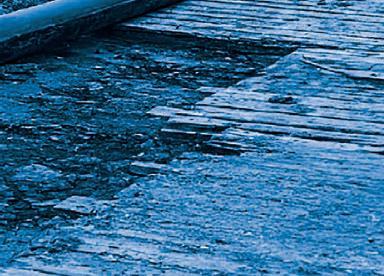
In 2024, Pipe Tek’s services have grown to include a full turnkey pipeline repair and remediation service, which includes identi cation of anomalies via in-line inspection, live-line dig ups, pipeline repairs, including welding, pressure wrap coatings and preventative eld-joint coatings and veri cation by phased array.
In addition to technicians experienced with Enduro’s products, the company also has experienced technicians certi ed to provide fast and safe installation of ClockSpring coil and breglass wrap repair sleeves, and Stopaq wraps for corrosion prevention.
“Our services have become more diverse so that we can keep pipeline integrity and maintenance simple for our clients, while saving them time and money,” Brannelly said.
Farrant agreed and noted the importance of working with one service provider.
“Dealing with the one service provider that can do it all uncomplicates the process and gives our clients the con dence that their asset is in safe hands.”
Myles Brannelly on 0417 707 729

















Curtiss-Wright EST Group’s open-end test plugs have been proven to save time spent on welding on and cutting o end caps to perform pressure testing.
Curtiss-Wright EST Group (EST Group) manufactures open end test Plugs to facilitate pressure testing on piping systems.
EST Group’s GripTight line of test plugs have proven themselves to save up to 85 per cent of the time spent welding on/cutting o end caps to perform pressure testing of pipe spools, piping systems and pressure vessels.
GripTight plugs are safe and e ective and have a proven track record on major liqui ed natural gas (LNG) projects in the Asia Paci c region, including Gorgon LNG modules, Queensland Curtis LNG (QCLNG) modules, Australia Paci c LNG (APLNG) modules, and Gladstone LNG (GLNG).
With sizes ranging from DN10 to DN1200 and pressure ratings to 1034BarG, GripTight plugs are an ideal solution for several applications. e QCLNG project team reported that they experienced a ve time increase in the number of test packages completed weekly when they shifted from using welded end caps to GripTight plugs.
GripTight plugs are reusable for several test cycles, making them a more cost-e ective solution over welded end cap methods of testing, ultimately providing customers with the lowest cost per test.
One distinctive feature of GripTight plugs is their patented dual-serrated gripper design.
GripTight MAX and GripTight Elbow plugs are currently being used in the modular construction of a major LNG expansion project in Australia. is method of hydrostatic testing remains to be a timely and cost-e ective way to keep your project on track and on budget.
While the concept of test plugs is still relatively unknown by many construction contractors in the pipeline arena, EST Group’s Sales Partner in Australia, PipeServ, has worked tirelessly with contractors and testing companies to adopt GripTight Test Plugs in three areas.
Conducting hydrostatic testing provides peace of mind to both the contractors and the end-users that the pipeline is constructed to withstand the pressures and conditions it will encounter during operation.

Welding on end caps or test headers to test these individual sections can be extremely time consuming for little return on the project as it consumes more resources than necessary.
Temporary hydrostatic test plugs free up welders to carry out the more permanent, revenue generating welds.
Testing emergency pipes helps ensure that operators are prepared to respond promptly and e ectively in the event of a pipeline incident. By conducting tests, operators can identify any issues with emergency response equipment or procedures and address them proactively, minimizing the impact of potential emergencies.
Although valves are typically tested at the factory before being shipped, re-hydrotesting allows pipeline operators to verify the integrity and functionality of the valves upon receipt. is is an additional quality assurance measure to ensure the valves meet the required speci cations and standards of the project.
Often, “pup” pieces do not have extra green on them for welding on end caps to close the valves o .
Utilising the open-end test plugs in this space
certainly makes the local hydrotest quicker and more cost e ective.
As industry shifts its focus to carbon capture, desulphurisation and hydrogen, there is an appreciable increase in open end test plug inquiries and sales.
eir cost-e ectiveness and time savings to expedite hydrotest packages is adding to the bottom line and speed of delivering crucial projects for contractors and end-users alike.
EST Group encourages those involved in managing project timelines, hydrotesting, precommissioning, quality and safety and would like a demonstration or more information, reach out.


• First to move the vacuum reservoir from the excavator stick to the counterweight
• First to use the excavator hydraulics to power the vacuum pump
• First to remove radio remote control
• First to introduce dedicated excavator operator controls
• First to introduce 360˚ rotation
• First to develop an in-trench pipe assembly apparatus
• First to develop an hydraulically assisted multiple o ring jointed pipe assembly tool


• First to develop a remote controlled in pipe inspection tool
• First to develop a VacLift that will only release a pipe when the pipe is on a solid surface
• First to increase the range of diameters able to be handled by each pipe shoe
• First to develop a fully adjustable attachment pickup.
We know the industry better than anyone, talk to us about all your pipeline plant hire needs first.
Cortec’s VpCI-379 liquid concentrate is all about saving labour and eliminating oily mess with a safe, water-based rust preventative.
Taking a sustainable approach to ghting corrosion and extending the life of metal surfaces and equipment parts is the main mission of Cortec Corporation.
Unlike traditional rust preventatives that rely on petroleum, Cortec water-based alternatives are globally known as environmentally responsible options improving worker experience.
Cortec’s goal is to create corrosion protection solutions that are safe, e ective, and equally important and economical wherever possible.
Cortec’s VpCI-379® is a cost-e ective, waterbased corrosion inhibitor liquid concentrate.
Specially designed by Cortec’s engineers to comply with strict anti-pollution standards, the VPCI-379 also has the added bene t of being easy to apply.
VpCI-379 is engineered for multi-metal corrosion protection in sheltered areas, such as indoors or within containers shielded from direct exposure to rain and outdoor elements.
Its vapor phase functionality enables some migration to areas susceptible to humidity and corrosive agents when used within an enclosed space.
With strong protection for uncoated surfaces, VpCI-379 is designed as a complete replacement for hazardous oil-based rust preventives. e wide dilution range (between ve and 50 per cent) allows exibility and enables signi cant cost savings.
“It provides superior protection against humidity and eliminates cleaning and housekeeping problems associated with oils,” Cortec said.




VpCI-379 forms a clear and dry lm which renders an attractive appearance on protected parts. e product will also become dry-totouch in ambient conditions 30 minutes after application, meaning wait times are drastically reduced.
VpCI-379 leaves a hydrophobic protective layer on metal surfaces and is easy to remove with conventional alkaline cleaners, if necessary. It also may be painted over with some common paints and primers without removal. ere are several typical applications for
Cortec’s VpCI-379, including:
• Castings, forgings, tubular parts, machined/ honed metal components.
• Gears, pumps, electric motors, housings, textile and printing equipment.
• Precision machined parts; structural steel; sintered metals, bars, and roll stock.
• Additive to parts washers and rinse water systems, hydro blasting, hydrotesting. is product is available through Savcor Products Australia in Australia and New Zealand.

















One of Papua New Guinea’s agship projects is the PNG LNG Project, a collaborative e ort involving ExxonMobil, Santos, and Kumul Petroleum.

Tproject will be a key focus of the PNG Industrial and Mining Resources Exhibition and Conference (PNG Expo), held from July 3–4 in Port Moresby.
Since its beginning in April 2014, the PNG LNG project has continued to play a crucial role in Papua New Guinea’s energy sector and broader economic development.
It has not only transformed Papua New Guinea’s energy landscape but it has also contributed to its emergence as a key player in the global LNG market.
In fact, the project has already paid over $5 million to its home of Central Province since the start of LNG production.
In 2021 alone, the Province earned record revenues from the project, with almost $900,000 delivered to the Papua New Guinean Government.
ExxonMobil PNG managing director Peter Larden said the revenues and associated bene ts from the PNG LNG Project provided the government the opportunity to promote sustainable, long term economic development.
contributing to the PNG economy,” he said. “We are pleased to see this increased revenue going to the area.”
e PNG LNG project started its development phase in 2008, with construction commencing in 2010 and rst LNG production achieved in 2014.
It truly takes a village to deliver such a monumental project – hence the collaboration between three major key players: ExxonMobil, Santos, and Kumul Petroleum.
ExxonMobil and Santos have brought extensive technical expertise in LNG production, exploration, and project management, which were essential for successfully developing and operating the complex LNG facilities.
ExxonMobil’s global presence and market access, coupled with Santos’s experience in energy markets, has facilitated the sale and export of LNG to international markets.
roughout the process, Kumul Petroleum represented the interests of the Papua New Guinean Government, ensuring that the project aligned with national development goals.
e PNG LNG project has involved extensive
The PNG LNG project continues to play a crucial role in Papua New Guinea’s energy sector 10 years since its inception. Image: PX Media/stock.adobe.com
natural gas reserves. Subsequent development phases included the construction of production facilities and infrastructure.
e primary objective of the project is to produce LNG for export markets. In 2014, PNG LNG successfully commenced LNG production and export, contributing to Papua New Guinea’s revenue and economic growth.
e project has also strengthened Paupa New Guinea’s position in the global energy market through strategic partnerships with international stakeholders. It has facilitated trade relations and positioned the country as a reliable LNG supplier.
e PNG LNG project has had an unparalleled economic impact on Papua New Guinea. LNG exports have generated substantial revenue for the government, supporting infrastructure development, social programs, and economic diversi cation.
If you are interested in exhibiting , visit pngexpo.com or contact Sales Manager KahChi Liew on kahchi.liew@primecreative.com.au.
Secure your PNG Expo ticket today. Tickets are available online only at pngexpo/attend.com.


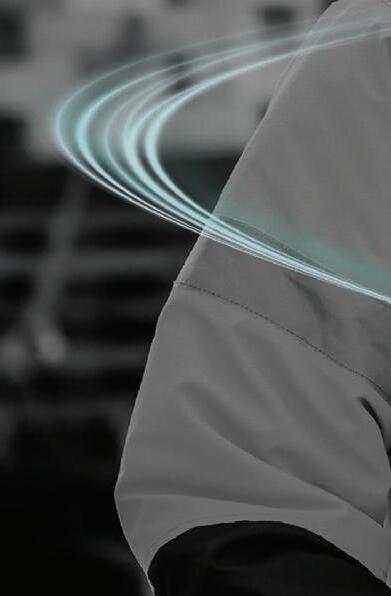




CONSTRUCTION CONTRACTOR
Alltype Engineering
Altrad Services Pty Ltd
Enscope Pty Ltd
Future Fuels CRC
Global Engineering & Construction Pty Ltd
HH Civil Pty Ltd
Maxibor Australia
McConnell Dowell Constructors (Aust) Pty Ltd
Michels Corporation
Mitchell Water Australia Pty Ltd
Moody Civil & Pipe Pty Ltd
MPC Kinetic
Nacap Pty Ltd
National Australian Pipelines
P and G Welding Pty Ltd
Pipecraft
Pipeline Plant Hire Pty Ltd
Quanta Services Australia Pty Ltd
Service Stream
Spiecapag Australia Pty Ltd
Steel Diamond
TESMEC Australia
ACIL Allen Consulting
Australasian Corrosion Consultants Pty Ltd
CNC Project Management
DNV GL Australia Pty Limited
Energy Matrix Group Pty Ltd
EnergyQuest Pty Ltd
Fortin Pipelines
Future-Proof Solutions
Jiva Consulting
JLL Infrastructure Advisory Pty Ltd
Land Access & Management Services Pty
Ltd
MVC Services Pty Ltd
OC Project Services Pty Ltd
Pipeline Engineering Consultants
Plant & Platform Consultants Ltd
Quest Integrity
Sage Consulting Solutions Pty Ltd
Sustech Engineering Pty Ltd
Ted Metcalfe Independent Consultant
Twycross and Partners Pty Ltd
Veris
ENERGY DISTRIBUTOR
ATCO Gas Australia
Powerco Limited
ENGINEERING/PROJECT MANAGER
A J Stack Solutions Pty Ltd
AFS Projects
Atteris Pty Ltd
Auscor Pty Ltd
Bamser Holdings Pty Ltd
Core Group Limited
Fyfe Pty Ltd
GHD Pty Ltd
GPA Engineering Pty Ltd
Lidiar Group
Long Energy and Resources (Aust.) Pty Ltd
Momentum Engineering
Pipeline Drillers Group
Solarig Australia Pty Ltd
SPIE Plexal
Vaughan Civil Pty Ltd
Verbrec Ltd (ASX: VBR)
Worley Services Pty Ltd
GOVERNMENT DEPARTMENTS/ REGULATORS
Department for Energy and Mining
Department of Planning and Environment
NSW
Energy Safe Victoria
Resources Safety and Health Queensland
INDUSTRY ASSOCIATION
Pipeline Research Council International, Inc
PIPELINE OWNER/OPERATOR
Ampol Australia Petroleum Pty Ltd
APA Group
Arrow Energy Pty Ltd
AusNet Services
Australian Energy Market Operator
Australian Gas Infrastructure Group
Beach Energy Limited
Brook eld Infrastructure Group
Channel Infrastructure NZ
Epic Energy SA Pty Ltd
Esso Australia Pty Ltd
First Gas Ltd
Fortescue Future Industries Pty Ltd
GB Energy
Jemena
Methanex NZ Ltd
Mobil New Zealand Oil Limited
Mobil Oil Australia Pty Ltd
Origin Energy Limited
Power and Water Corporation
PowerGas Limited
Qenos Pty Ltd
QGC
Santos Ltd
SEA Gas
South Australian Water Corporation
Tas Gas Holdings Pty Ltd
Tasmanian Gas Pipeline Pty Ltd
Construction Contractor TESMEC Australia - CMB - Adrien Merceron
Vector Limited
Viva Energy Australia Ltd
Woodside Energy Ltd
SERVICE PROVIDER
Atlas Copco Rental Oceania
Avmin Pty Ltd
AXS Pty Ltd
Baker Hughes
Brooks Hire Service Pty Ltd
Brownline Australia Pty Ltd
Bureau Veritas Asset Integrity and Reliability
Services Pty Ltd
Corrosion Control Engineering (Holdings) Pty
Limited
Deaton Enterprises Pty Ltd trading as CST
Hire
Downer EDI Engineering Power Pty Ltd
DSQ Pty Ltd
ERIAS Group Pty Ltd
IntelliGas
ITI International
Kent
LandPartners Pty Ltd
Lochard Energy (Iona Operations) Pty Ltd
Mipela GeoSolutions
NDT Global Pty Ltd
Oceaneering Australia Pty Limited
ORIX Commercial
Peter Norman Personnel Pty Ltd
Picarro, Inc
Pipe Tek Pty Ltd
Piping Specialty Supply Service Pty Ltd
Prime Creative Media
Pro Pipe Services Pty Ltd
Project Communications Australia
QIC Protective Coatings (Aust) Pty Ltd
Qube Energy Pty Ltd
Red Rock Oil eld Services
Rogers Energy Services
ROSEN Australia Pty Ltd
Scape Consulting Pty Ltd
SRG Global
STATS Group
T D Williamson Australia Pty Ltd
TFG Group Pty Ltd
Turbo Systems Australia Pty Ltd
Vertech Group Pty Ltd
Viega Pty Ltd
Wasco Energy Group
WRAP Resources Australia
Zinfra
SUPPLIER OF EQUIPMENT OR MATERIALS
Aegis Pty Ltd
Anode Engineering Pty Ltd
Anti Corrosion Technology Pty Ltd
Aquip Systems
AtlasGas Pty Ltd
Austrack Equipment Sales and Rentals
Australian Pipeline Valve
Australian Portable Camps
Bao Australia Pty Ltd
CRC-Evans Pipeline International
Delnorth Pty Ltd
Denso (Australia) Pty Ltd
EagleBurgmann Australasia Pty Ltd
EDMI Pty Ltd
FPK (FERRET INDUSTRIES)
Gasco Pty Ltd
GF Piping Systems
Heath Pipeline Services Pty Ltd
Herrenknecht AG
Inductabend Pty Ltd
iPipe Services
Iplex Pipelines Australia Pty Ltd
Jindal Saw Limited
LFF Australia
Lincoln Electric Company (Australia) Pty Ltd
Marubeni-Itochu Tubulars Oceania Pty Ltd
McElroy Australia
Ozzies, Inc.
PAC
Paci c Valve Tech & Engineering Pty Ltd
Pipeline Equipment Rentals
Pipeline Machinery International LP
Pipeline Supplies Australia
PipeServ
PSAH Pty Ltd
RazValve Paci c
RDO Equipment Pty Ltd
Richmond
RTi Asia Paci c PTY LTD
Savcor Products Australia Pty Ltd
Scapeworks Australia
Shawcor Pty Ltd
SICK Pty Ltd
Solar Turbines Australia
Tapex Industrial
Techrite Controls Pty Ltd
TRACTO-TECHNIK Australia Pty Ltd
Tremco Pipeline Equipment Pty Ltd
Universal Corrosion Coatings Pty Ltd
Vacuworx Australia
Vinidex Pty Ltd
Vlentec Australia Pty Ltd
Welspun Corp Limited
Western Process Controls
Worldwide Group
would particularly like to acknowledge the generous support of its Owner
• APA Group
• Australian Gas Infrastructure Group
• Epic Energy SA Pty Ltd
• Jemena
• SEA Gas
• Tasmanian Gas Pipeline Pty Ltd
• Australian Portable Camps
• Esso Australia Pty Ltd
• McConnell Dowell Constructors (Aust) Pty Ltd
• MPC Kinetic
• Nacap Pty Ltd
• Ken Barker
• David Curry
• Keith Fitzgerald*
• D C Gore*
• Robert Gration
• Max Kimber
• QGC
• Quanta Services Australia Pty Ltd
• Solar Turbines Australia
• Spiecapag Australia Pty Ltd
• Worley Services Pty Ltd
• Andy Lukas
• Tony Marletta
• Mick McCormack
• Stuart McDonald
• Jim McDonald*
• Allan Newham
• Dean Barker
• Paul Beukelman
• John Blain
• Bevan Boocock
• Grant Bowley
• Stephen Callaghan
• Ken Cameron
• Chris Carter
• Mark Cooper
• Geo Cope
• John de Robillard
• Daniel De Vere
• Amy Farrugia
• Gretchen Gagel
• Chris Gatehouse
• Graeme Hogarth
• Eric Bardy
• Geo Barton
• Lauren Beynon
• Rick Boreham
• Andrew Bourke
• Liz Brierley
• Peter Bucki
• Francis Carroll
• Philip Colvin
• Vera Corso
• Anne-Maree Corson
• Craig de Laine
• Edwin De Prinse
• Mark Dragar
• Yuyu Fang
• Daniel Faulkner
• Matt Felvus
• Sean Fleming
• Nick Flint
• Tom Forde
• Mark Fothergill
• Paul Frederick
• Tess Gardener
• Jarrod Gilby
• Calvin Gordon
• Peter Hanily
• Geo Harrison
• Lynndon Harnell
• Mark Harris
• Chris Harvey
• Justine Hyams
• Je Jones
• Ashley Kellett
• Steven Liddell
• Cameron
• Stephen Ohl
• Mark Twycross
• Phil Venton *deceased
MacDiarmid
• James McMahon
• Trevor Nichols
• John Piper
• David Pollock
• Brett Reay
• Justin Sciortino
• Shaun Smith
• Ian Spence
• Jasper Tieland
• Andrew Wood
• Chris Hewson
• Ian Israelsohn
• Linda Johnson
• Hugo Kuhn
• Trent Leach
• David Levy
• Nicole Lowndes
• Paul May
• Stephanie Maybury
• John Messent
• Stephen Mudge
• Matthew O'Connell
• Brian O'Sullivan
• Neil Parry
• Tawake Rakai
• Ben Rees
• Darren Rogers
• Josh Row
• Craig Sheather
• James Smith
• Colin Symonds
• Soheil Taherian
• Warwick Tidswell
• Andrew Tsitas
• John Walsh
• Sean Ward
• Louise Watson
• Rob Wheals
• Paul Williamson
• Michael Xanthopoulos
In this regular column, The Australian Pipeliner celebrates new appointments in Australia, New Zealand, Papua New Guinea, and the Pacific’s pipeline sector.

Jemena has announced the appointment of Kate Webster as the new Group Chief Financial Officer (CFO) following a competitive recruitment process.
Jemena Managing Director David Gillespie said that Webster brought a wealth of energy and utility sector experience to the role.
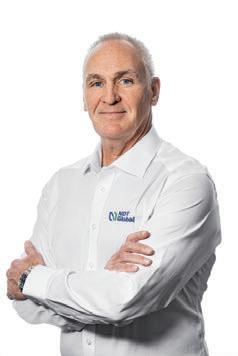
“We are thrilled to welcome Kate to the Jemena team and are confident she is a natural fit for our Group and will make a strong contribution to the business,” Gillespie said.
“Kate has an impressive understanding of not only the energy sector, but the challenges it faces – particularly in a financial context – as we work towards delivering on our net-zero ambitions.”
Gillespie said Webster had been working in the energy sector in a range of inhouse and consulting roles since 2001, most recently as CFO and co-CFO for a number of Australian-based energy infrastructure businesses.
“Kate’s experience also includes international positions in the energy sector, notably in the United Kingdom,” Gillepsie said.
Ron James has joined NDT Global as Director, Commercial Sales.
James has been offering highpressure isolation products and serving as the Sales Director for Europe and Africa at STATS Group for the past nine years.
James is now excited about his upcoming role at NDT Global for a variety of reasons.

“I look forward to collaborating closely with the European team and Previan sister companies - continuing the excellent work already done,” he said.
“Existing infrastructure and new projects will provide a platform for growth for years to come.”
NDT Global delivers operators the best inline diagnostic data with actionable insights to enable predictive analysis and long-term risk assessment.
“We provide baseline surveys for new assets, accurate wall measurements through the production phases as maintenance inspections, and marketleading crack detection life extension of aging assets,” James said.
According to him, NDT Global's technology is a real game-changer.
“The support of the facility in the region makes a difference in giving our customers confidence in our delivery.”
Following the acquisition of Piping Solutions by Saunders International in late 2023, Shane Tynan is the newly appointed General Manager of Saunders Piping Solutions.
In this role, Tynan leads the overall Saunders Piping Solutions business and operations.
“I consider myself fortunate to have a
fantastic team, loyal clients and strong pipeline - so it’s an excellent position to be in,” Tynan said.
“The synergy between the Saunders and Piping Solutions teams was already wellestablished, which has made navigating the business through a new ownership structure both interesting and exciting.”
Across his career, Tynan worked as a Mechanical Engineer, providing his skills at companies such as Shell and UGL.
“I’m looking forward to watching the evolution and growth of the business and team now that we’re a part of Saunders International,” he said.
“Structural and mechanical piping is a core capability within Saunders, so I know it will always be a key component of the overall offering and operations.
“Being part of a larger ASX-listed organisation will provide Piping Solutions broader capabilities and reach.”
If your company has recently employed a new person within your business you would like profiled in ‘People on the Move’, send details of the career news alongside a high-res photo to Editor Clemence Carayol at clemence.carayol@primecreative.com.au


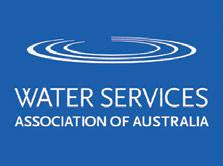




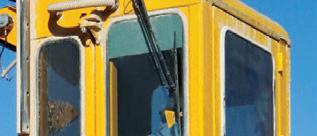
TECHNOLOGY SOLUTIONS FOR AUSTRALIA’S PIPELINE INSTALLATION.

SmartTEC Performance Software helps maximise machine performance by assisting operators with adjustments to machine controls during operation, and monitoring and recording machine performance, which can be analysed by the machine owner or eet manager. Contact your local Vermeer Australia team to learn how we can support your project.
